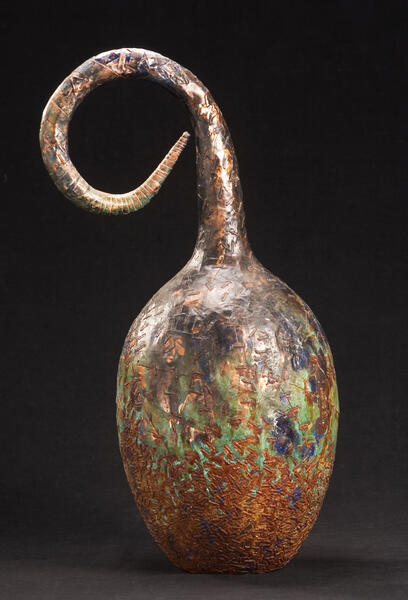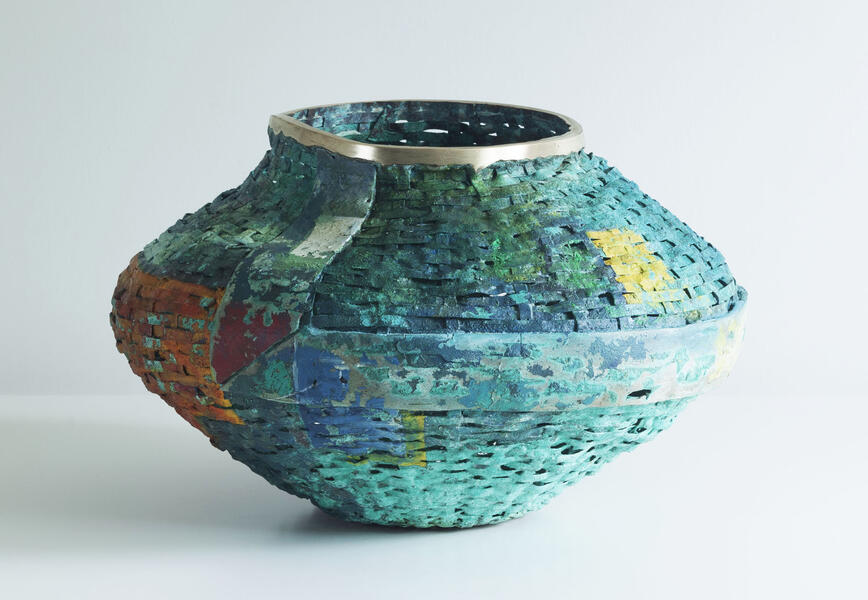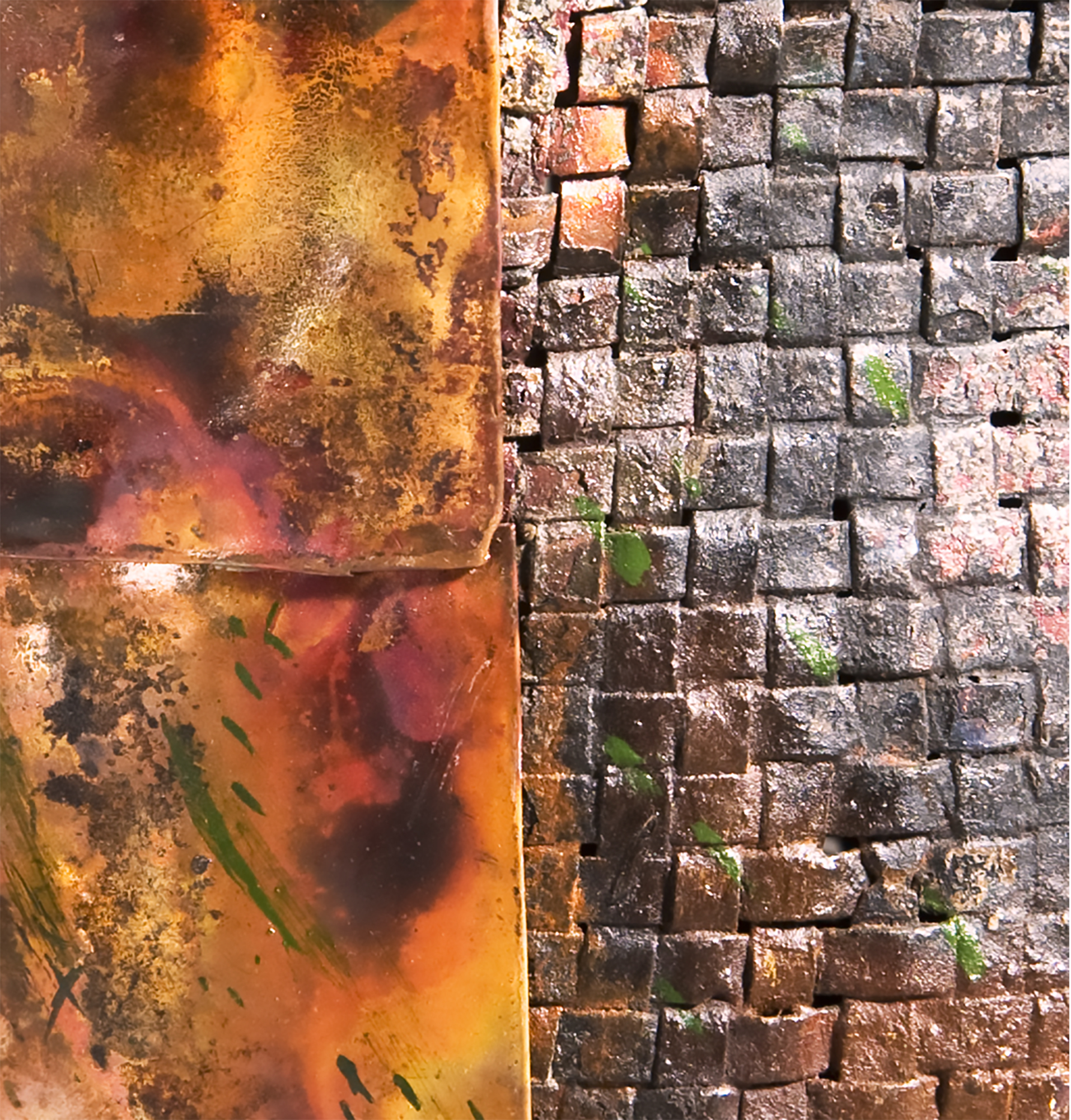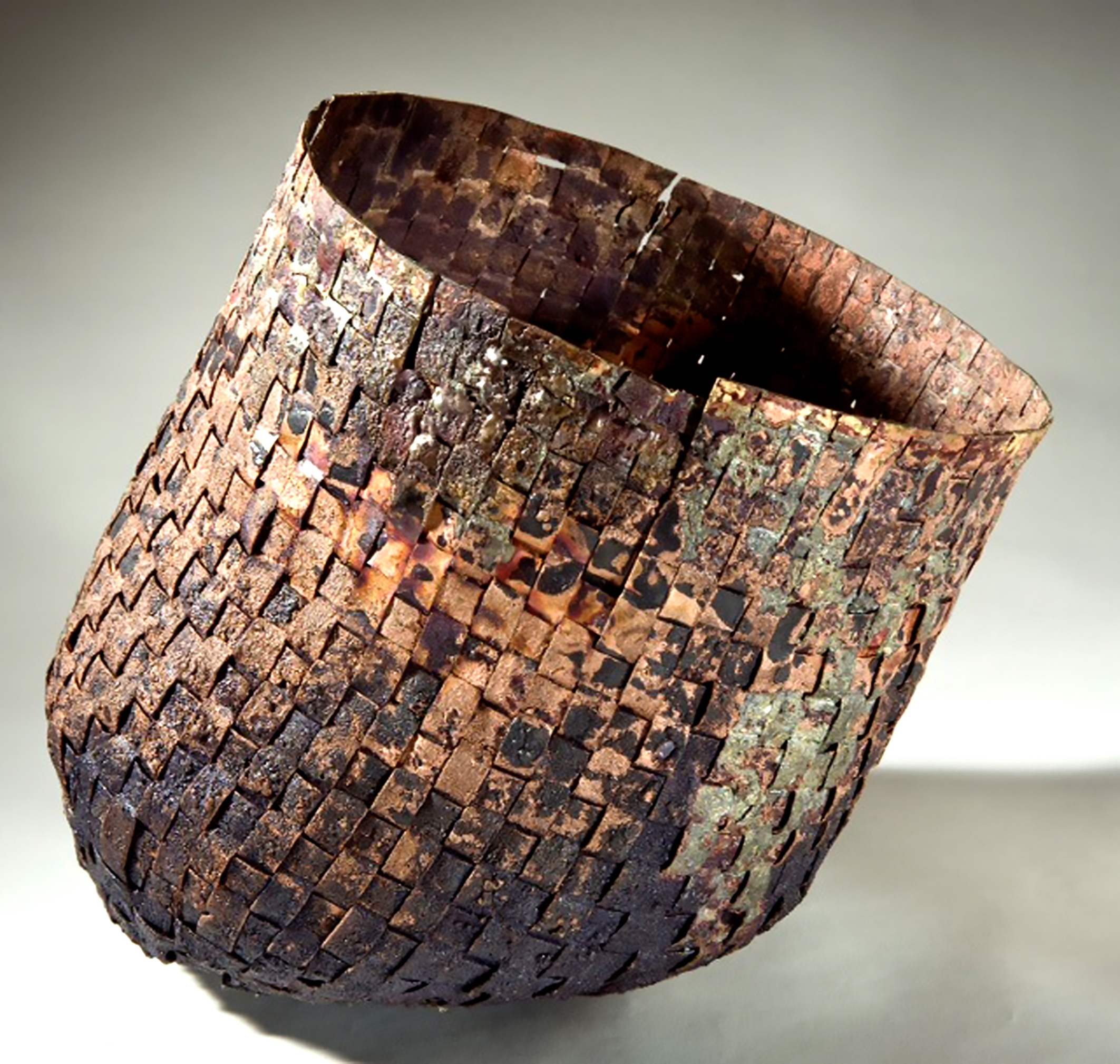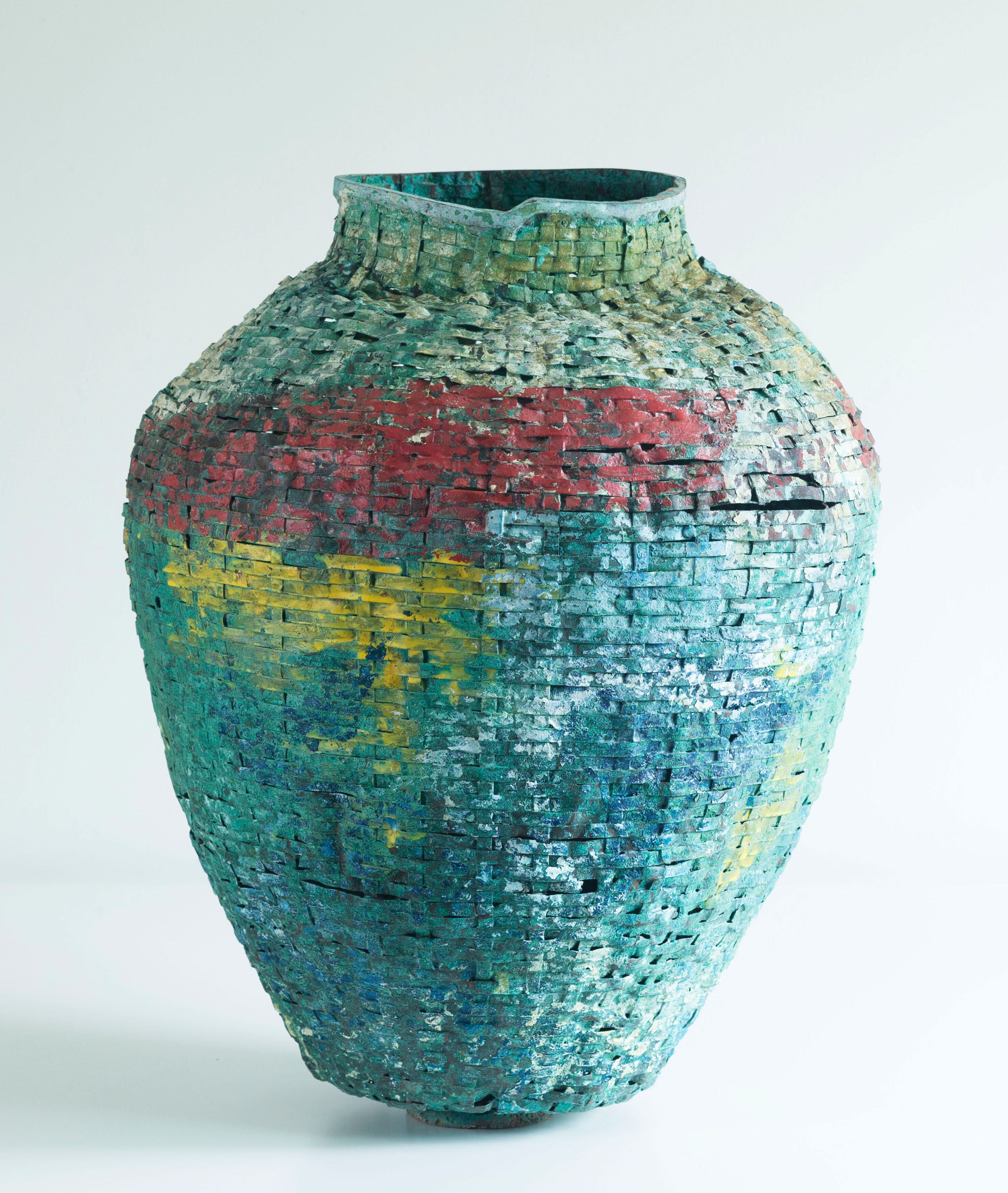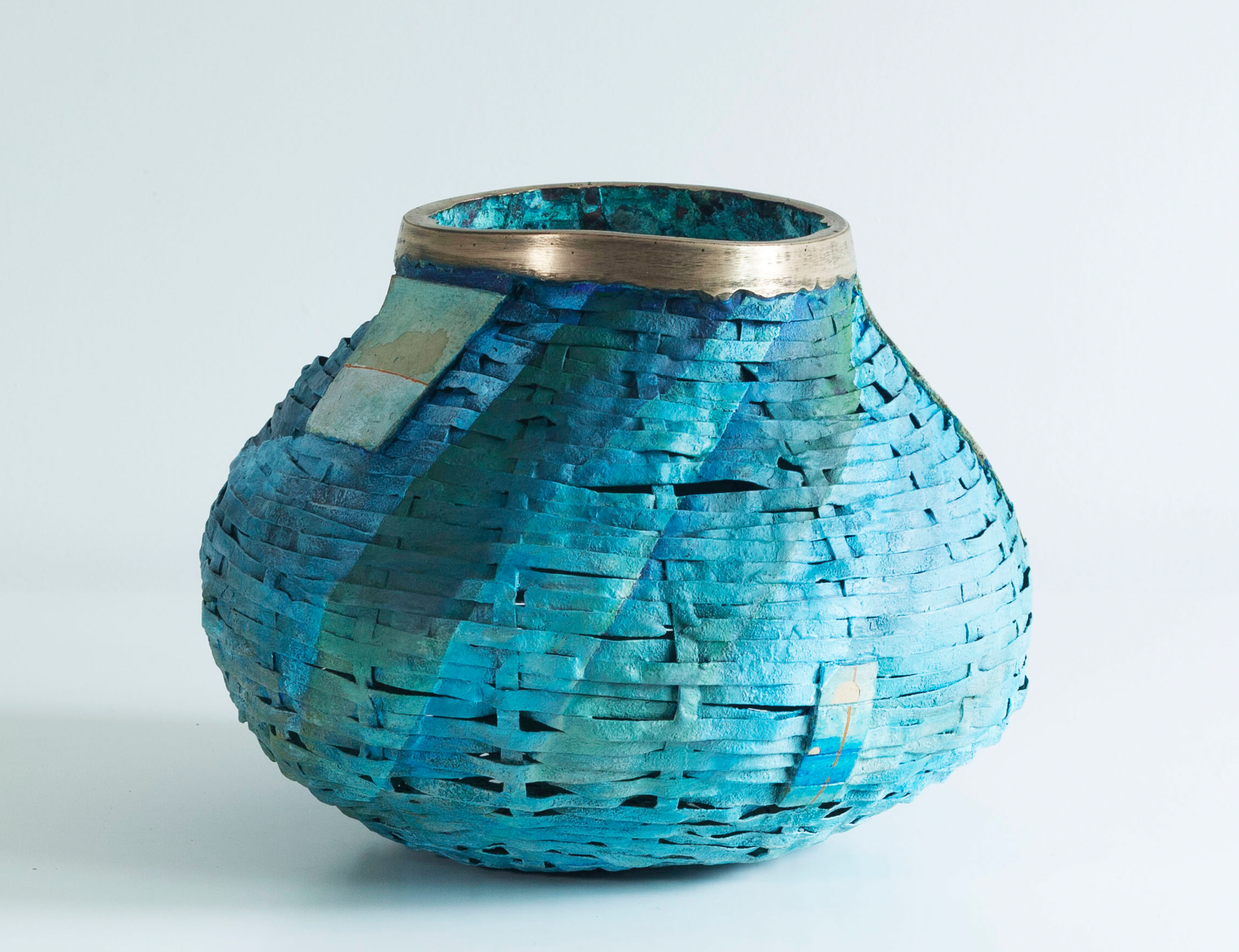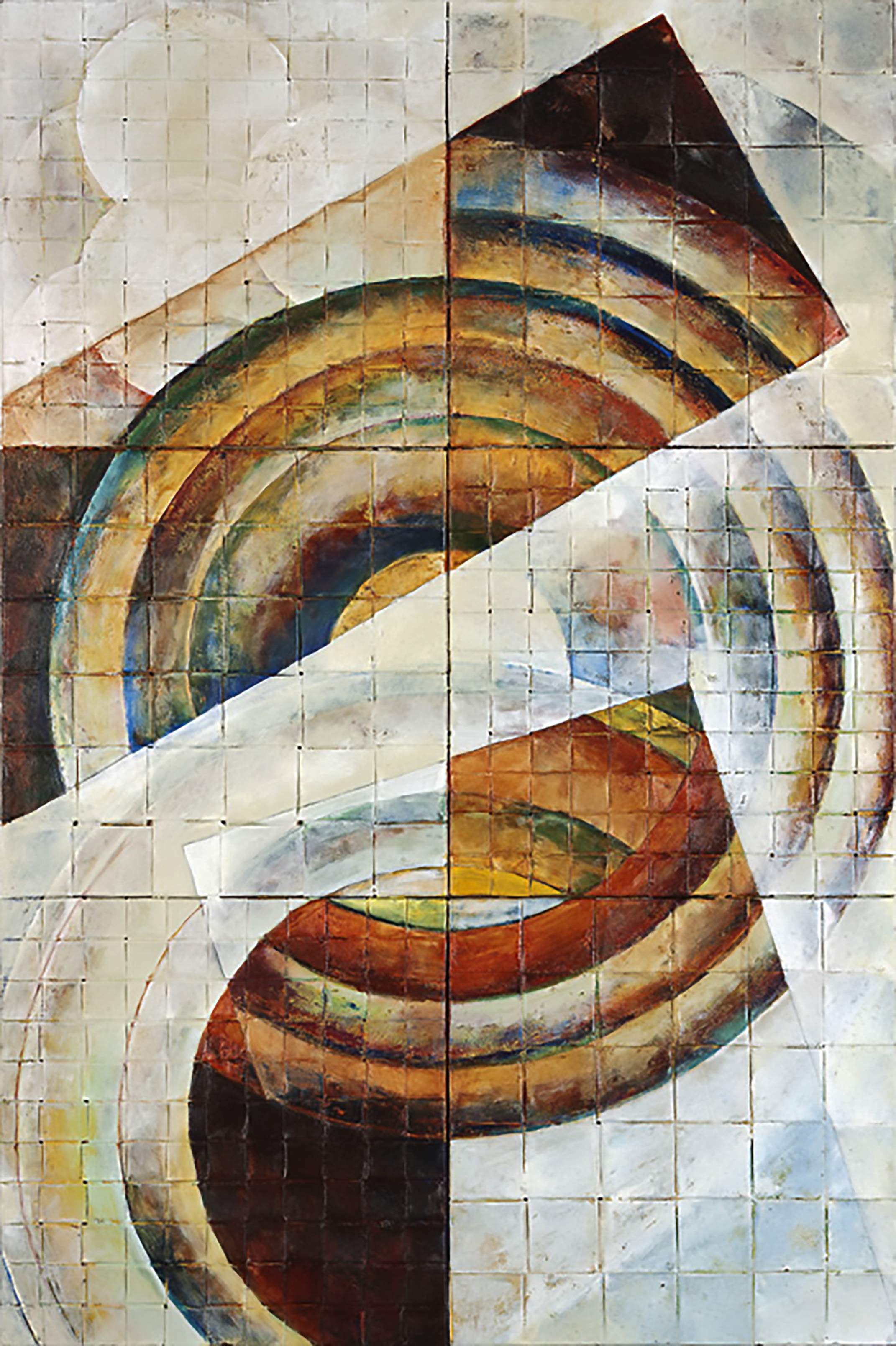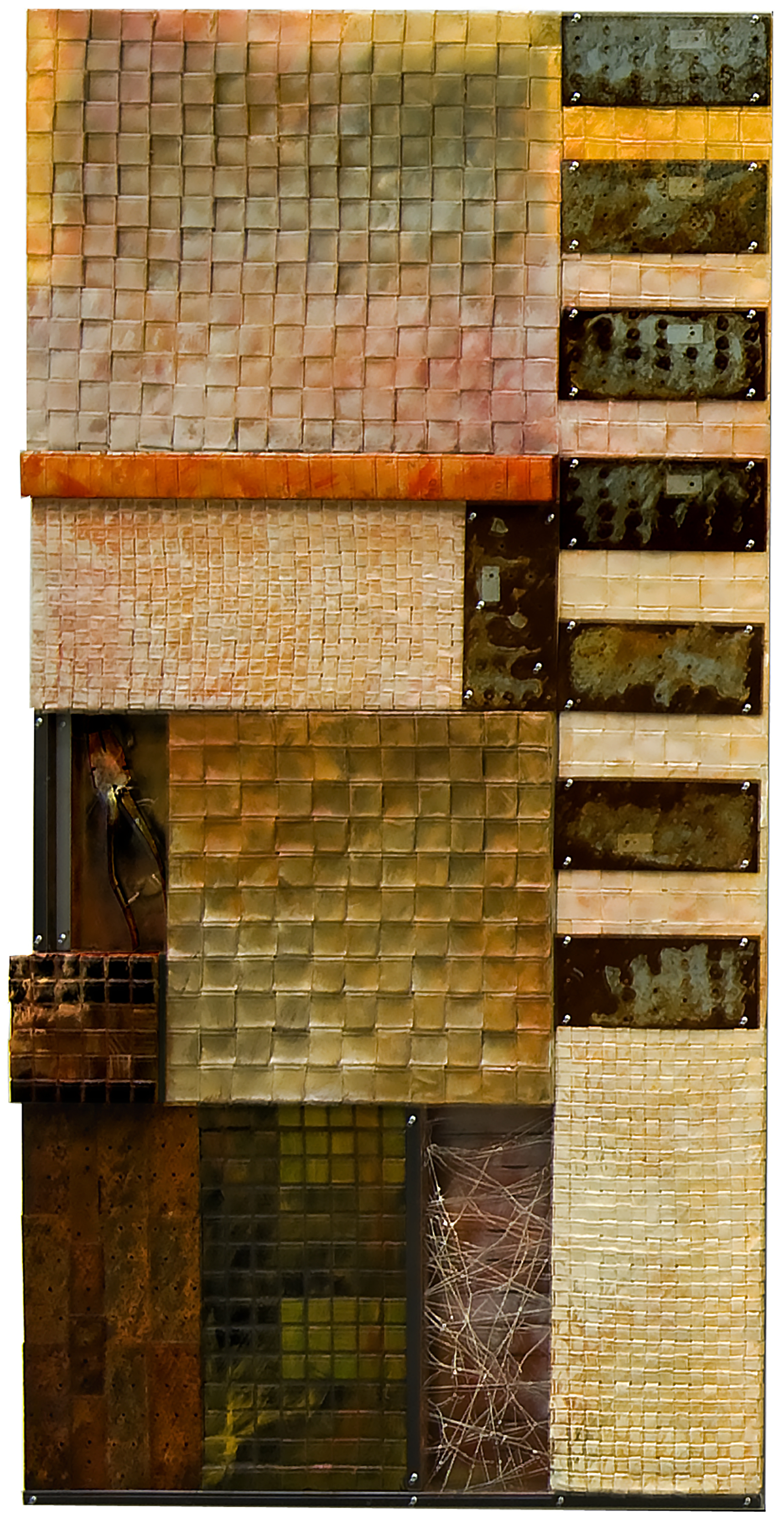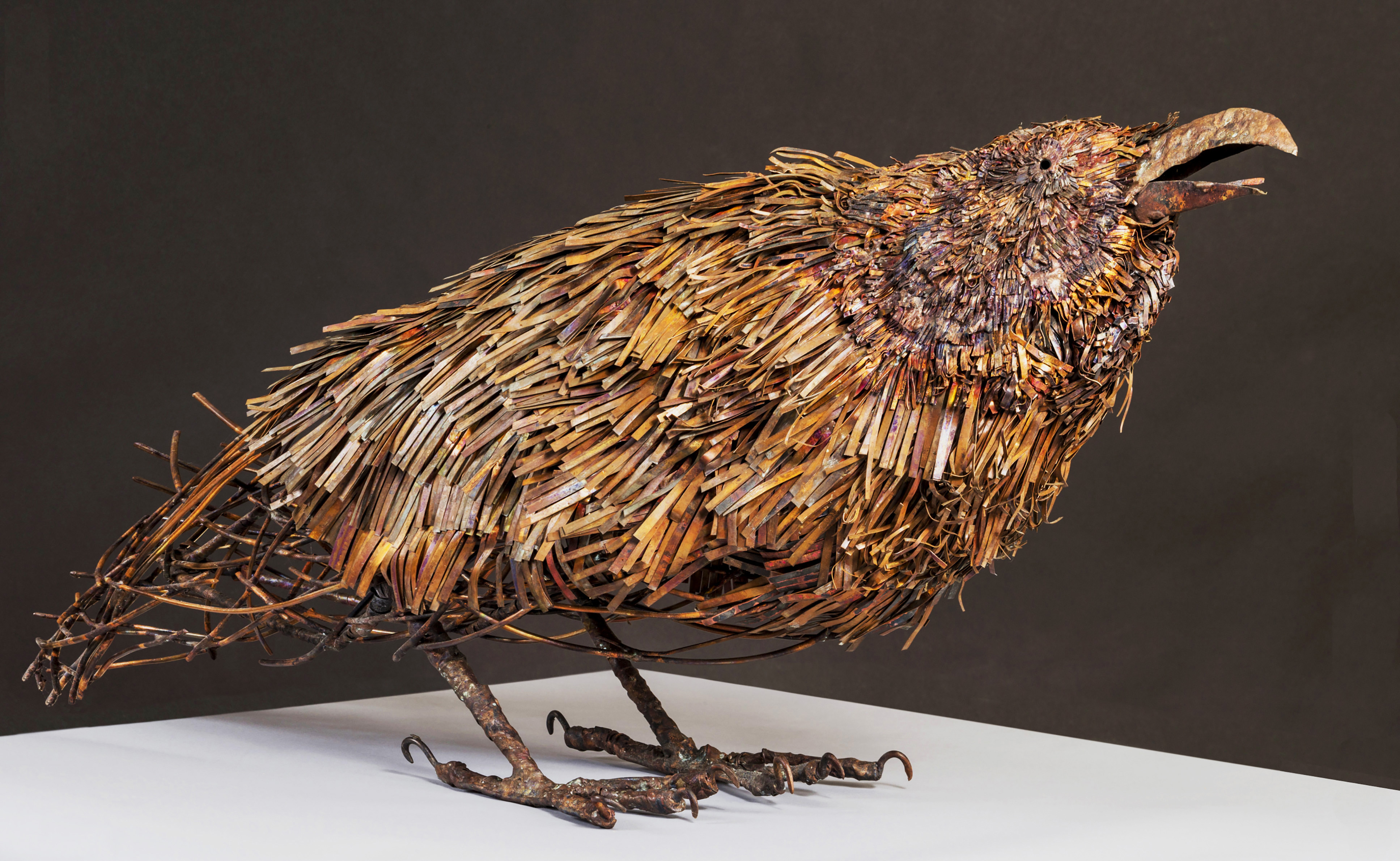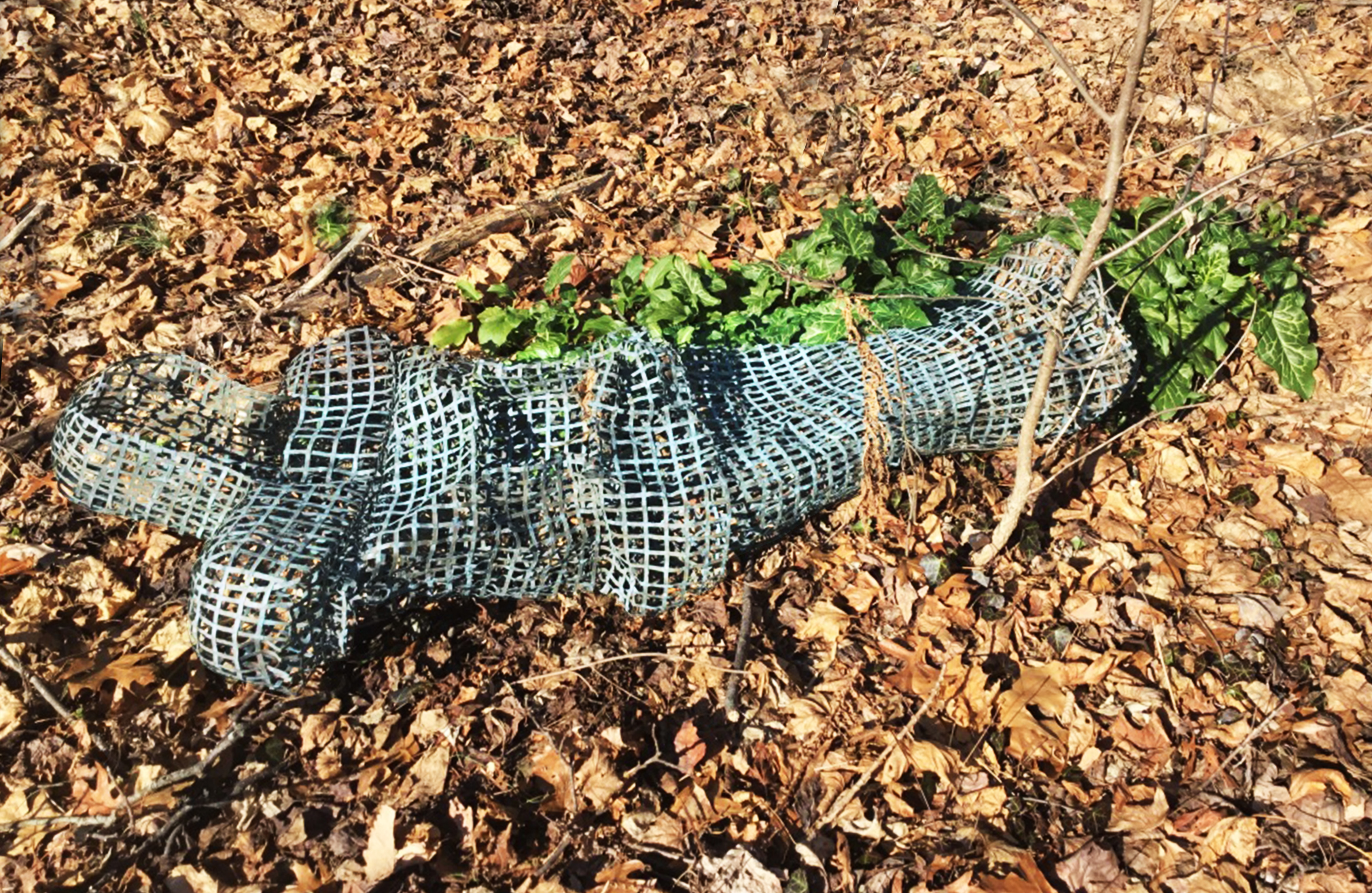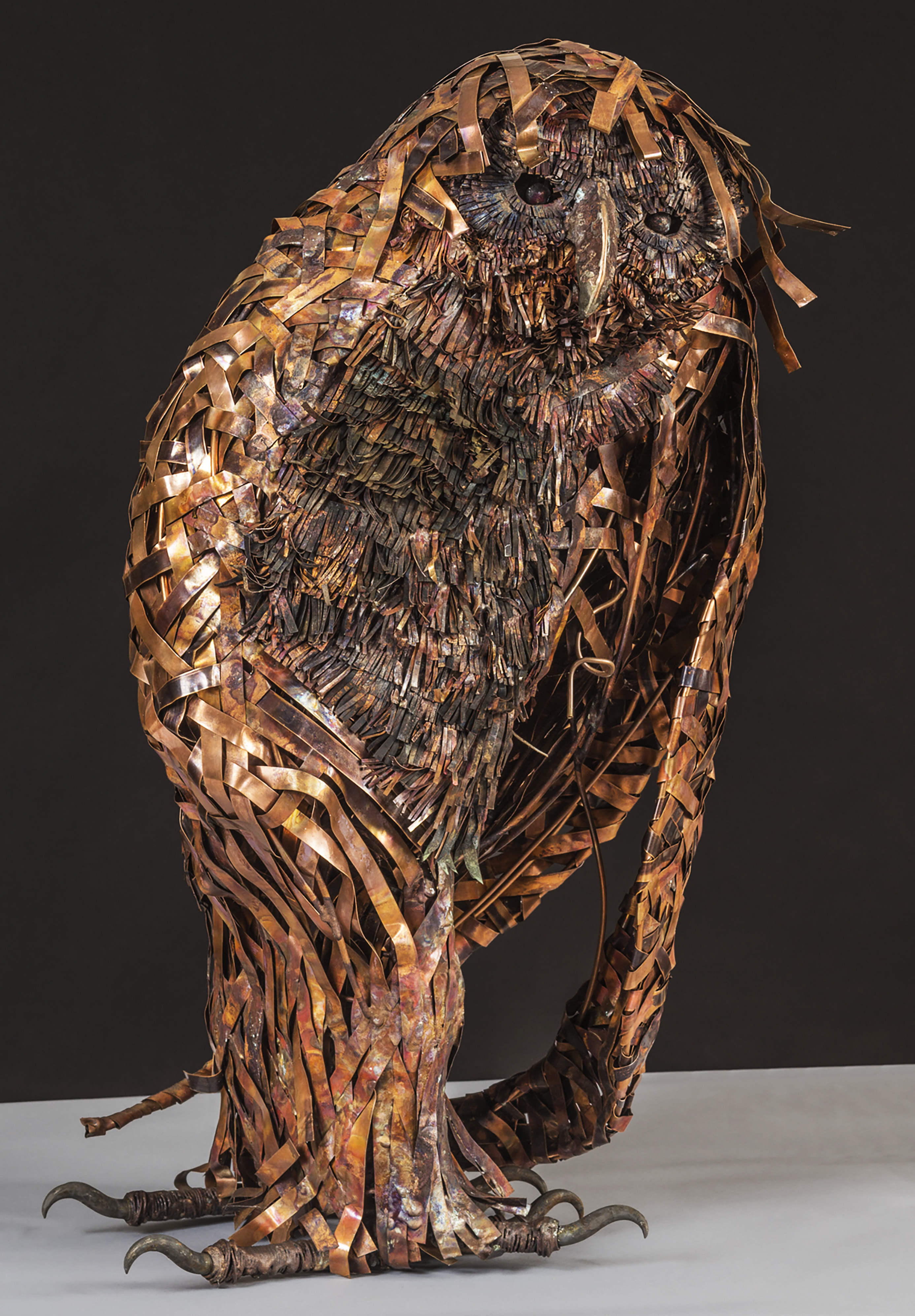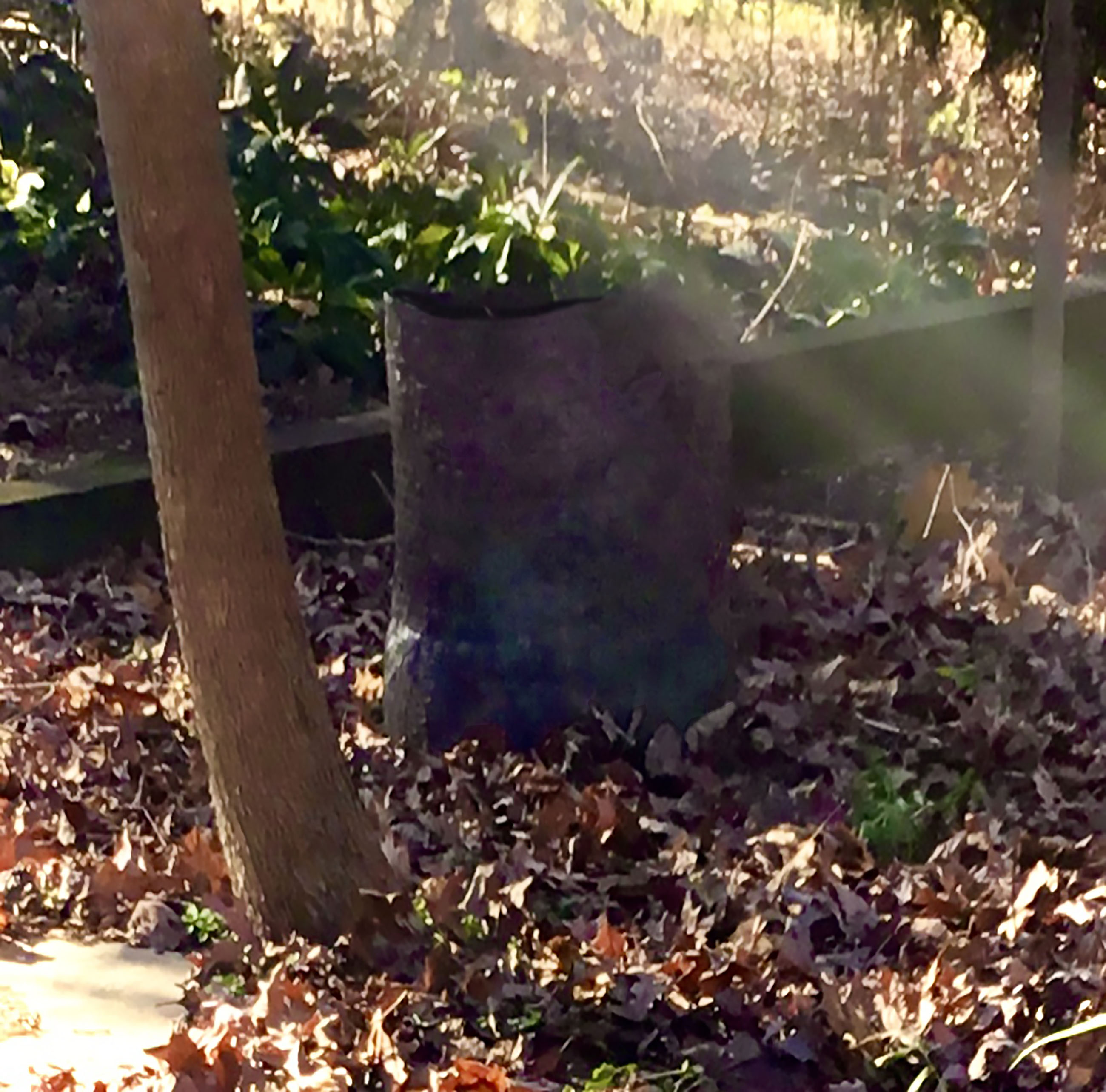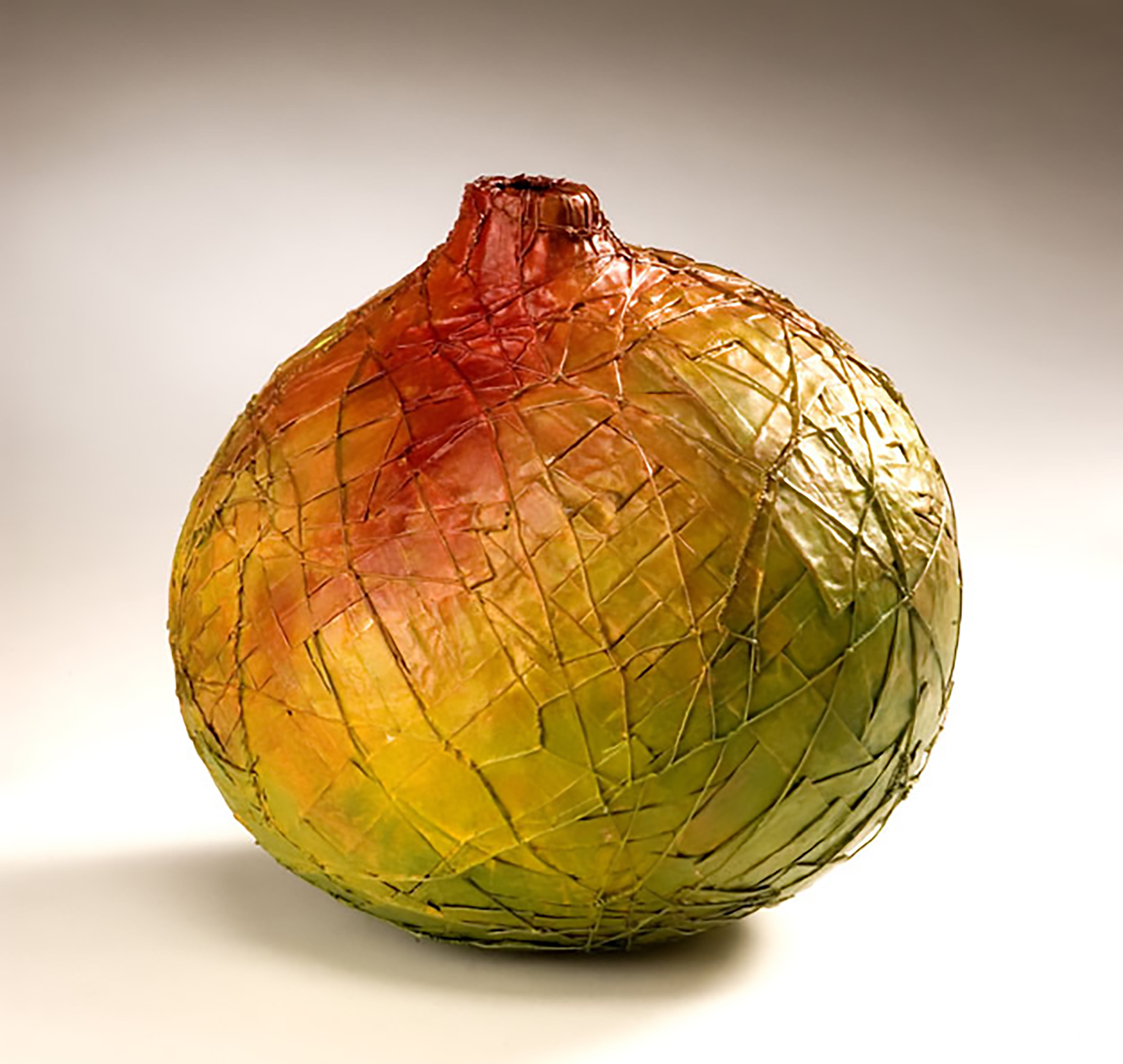Work samples
Share:
About David Paul
Baltimore County, 2024 OTW Artist
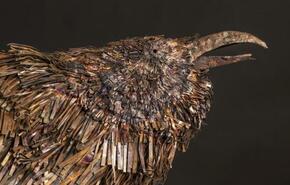
David Paul Bacharach (b.1949) was born in Baltimore, Maryland. At an early age he was taught watercolor painting and sewing by his grandfather, how to work metal and wood from his father and picked up a passion for weaving from his mother. He studied at Case Western Reserve University, receiving his B.A. in Biochemistry in 1971 and received advanced training in physiology in 1974 from the University of Maryland. David is totally self-taught as an artist. While still in high school he began exhibiting his work locally and then nationally. After teaching for 10 years at University of Maryland,… more
Jump to a project:
Copper
I love the taste of metal. Most people don't' spend sufficient time handling raw materials before they are polished, punished, coated, coerced, plaited, planished, and sealed to experience the individual tastes, smells, and secrets of a material other than possibly their food, but I have.
Copper is my favorite metal. It has a mineral-like taste with notes of spinach, new moan hay, and latakia that initially stains my fingers' chartreuse, which as I work ages to the color of the second pressing of olive oil. Copper is supple like silk, with a velvety surface so delicate it preserves the history of my fingers progress as they move across it.
I store my hoard of copper slittings and scrap outdoors. Like vegetation, it swells in the summer and shrinks in the winter. Like a tree, it develops a crusty green bark that progressively thickens and protects for decades. Like other non-natives, it can unfurl tendrils of spectacularly beautiful, tenacious green material that once mixed with bittersweet, English ivy, poison ivy, and multiflora rose is impossible to remove.
I love watching copper interact with nature, like a ground cover, copper shelters a mouse who repays the good deed with the gift of water, salt, and electrolytes to mark the friendly metallic surface. Copper slittings and wire, without my intervention, magically unfurl, twisting with wind and time to become ground cover, nest, and den material.
It was the year of the "great American total solar eclipse" that I disentangled my first rat's nest of copper slittings from a cradle of bittersweet and ivy, dragged it up to the bedroom, and dropped it on the bed. I was sick with the flu. Ordered to stay I bed, what to do? I was bored. Relaxing isn't in my nature. What do you do with 150 pounds of variegated, variable width, point-O-one-six thick metallic spaghetti? Crumbled, twisted, flayed like the skin of a grapevine; interdigitated so completely no single piece longer than thirty-six inches could be extracted.
I considered myself a craftsperson capable of exploring new materials, techniques, approaches. I preferred working with a few simple hand tools. I'd never made a basket, but why not. Pliers, tinsnips, band-aides, and I was ready. I completed my first basket three hours later. The rudimentary, plaited container sat proudly, its copper body pre-patinated by the elements, various mammals, and birds; on the foot of the bed. The warp and weft's misshapen fibers had been flattened with pliers not suited to the job leaving a spider web of scratches and folds that I found appealing. It was a market basket that appeared to have been plucked from the back porch of a long-forgotten farmstead. It was a beginning.
Copper is my favorite metal. It has a mineral-like taste with notes of spinach, new moan hay, and latakia that initially stains my fingers' chartreuse, which as I work ages to the color of the second pressing of olive oil. Copper is supple like silk, with a velvety surface so delicate it preserves the history of my fingers progress as they move across it.
I store my hoard of copper slittings and scrap outdoors. Like vegetation, it swells in the summer and shrinks in the winter. Like a tree, it develops a crusty green bark that progressively thickens and protects for decades. Like other non-natives, it can unfurl tendrils of spectacularly beautiful, tenacious green material that once mixed with bittersweet, English ivy, poison ivy, and multiflora rose is impossible to remove.
I love watching copper interact with nature, like a ground cover, copper shelters a mouse who repays the good deed with the gift of water, salt, and electrolytes to mark the friendly metallic surface. Copper slittings and wire, without my intervention, magically unfurl, twisting with wind and time to become ground cover, nest, and den material.
It was the year of the "great American total solar eclipse" that I disentangled my first rat's nest of copper slittings from a cradle of bittersweet and ivy, dragged it up to the bedroom, and dropped it on the bed. I was sick with the flu. Ordered to stay I bed, what to do? I was bored. Relaxing isn't in my nature. What do you do with 150 pounds of variegated, variable width, point-O-one-six thick metallic spaghetti? Crumbled, twisted, flayed like the skin of a grapevine; interdigitated so completely no single piece longer than thirty-six inches could be extracted.
I considered myself a craftsperson capable of exploring new materials, techniques, approaches. I preferred working with a few simple hand tools. I'd never made a basket, but why not. Pliers, tinsnips, band-aides, and I was ready. I completed my first basket three hours later. The rudimentary, plaited container sat proudly, its copper body pre-patinated by the elements, various mammals, and birds; on the foot of the bed. The warp and weft's misshapen fibers had been flattened with pliers not suited to the job leaving a spider web of scratches and folds that I found appealing. It was a market basket that appeared to have been plucked from the back porch of a long-forgotten farmstead. It was a beginning.
-
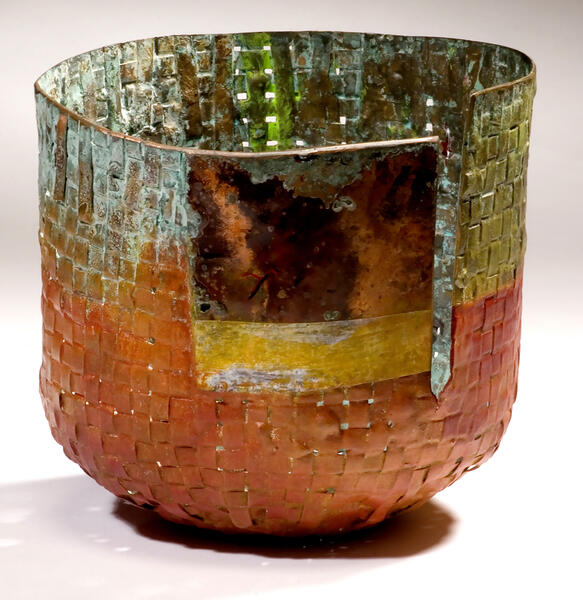 Autumn Bowl No.7When I first began basket making, I didn't appreciate the beauty of a well-made egg or market basket. So I initially gravitated toward the shapes of Japanese ikebana baskets and tea bowls. These intricate bamboo sculptural vessels intend to hold flower arrangements, and simple, hand-less unglazed ceramic forms guided my basketry endeavors for the next few years. Recycled materials, woven copper, brazed, chemical patina, polychrome 6" x 6.5" x 7".
Autumn Bowl No.7When I first began basket making, I didn't appreciate the beauty of a well-made egg or market basket. So I initially gravitated toward the shapes of Japanese ikebana baskets and tea bowls. These intricate bamboo sculptural vessels intend to hold flower arrangements, and simple, hand-less unglazed ceramic forms guided my basketry endeavors for the next few years. Recycled materials, woven copper, brazed, chemical patina, polychrome 6" x 6.5" x 7". -
 Tea Bowl No.11I began my basket making with copper because I enjoyed working with metal. Copper was readily available, inexpensive as scrape from local manufacturing companies, extremely malleable, durable, easy to solder with low-temperature equipment, and could I generate numerous colors inherent to copper with the application of simple chemical formulas or heat. Recycled materials, woven copper, chemical patina, polychrome 6” x 6.5” x 7”.
Tea Bowl No.11I began my basket making with copper because I enjoyed working with metal. Copper was readily available, inexpensive as scrape from local manufacturing companies, extremely malleable, durable, easy to solder with low-temperature equipment, and could I generate numerous colors inherent to copper with the application of simple chemical formulas or heat. Recycled materials, woven copper, chemical patina, polychrome 6” x 6.5” x 7”. -
 Tea Bowl Black, detail.jpgDetail, woven copper with silver oxide patina. Recycled materials, woven copper, fired silver oxide patina, polychrome.
Tea Bowl Black, detail.jpgDetail, woven copper with silver oxide patina. Recycled materials, woven copper, fired silver oxide patina, polychrome. -
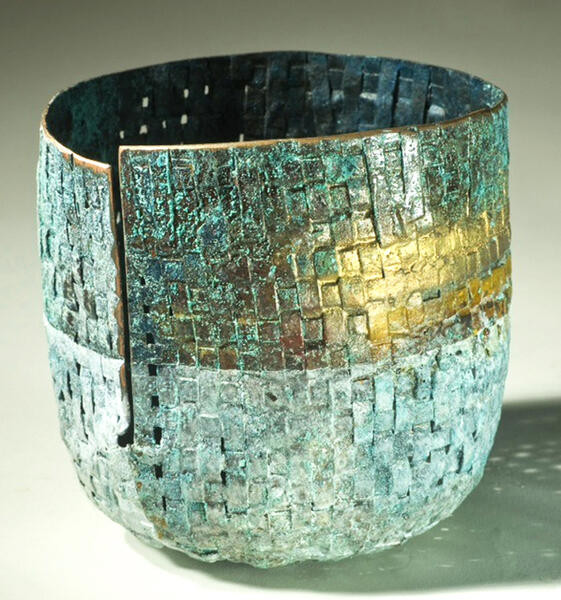 Tea Bowl Gilded No.14One of the first patinas I learned was fuming copper in a closed container with ammonia. The ammonia fumes created a blue-black color. Not beautiful in and of itself, but at the conservator's suggestion at the Freer Gallery in Washington, DC, I use an old Windex bottle to spray uric acid on the tea bowl. Viola! The uric acid turned my dusty blue-black patina a beautiful, permanently mottled chromate green. The same conservator showed me how to apply low karat gold leaf in a wispy fashion that appeared like a brushstroke to accent the green patina. Recycled materials, woven copper, chemical patina, polychrome 6" x 6.5" x 6".
Tea Bowl Gilded No.14One of the first patinas I learned was fuming copper in a closed container with ammonia. The ammonia fumes created a blue-black color. Not beautiful in and of itself, but at the conservator's suggestion at the Freer Gallery in Washington, DC, I use an old Windex bottle to spray uric acid on the tea bowl. Viola! The uric acid turned my dusty blue-black patina a beautiful, permanently mottled chromate green. The same conservator showed me how to apply low karat gold leaf in a wispy fashion that appeared like a brushstroke to accent the green patina. Recycled materials, woven copper, chemical patina, polychrome 6" x 6.5" x 6". -
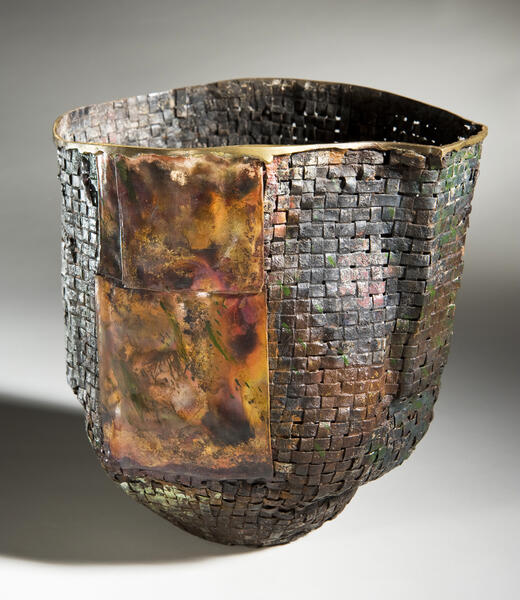 Tea Bowl Black No.21I scored an old electric potter's kiln in the mid-'70s. I had to do a bit of rebuilding, but it was soon working, and I immediately tried firing my baskets like a potter would a raku vessel. I was told by a good friend, a metals professor at a well-respected art institute, that the heat required to provide a permanent color change would cause my woven forms to collapse. In time, the repeated opening and closing of the kin would destroy it. I did not listen. I proceeded to experiment. Forms did collapse, and the kiln was frequently in need of repair. Eventually, I discovered a way to consistently judge the metal's temperature by its color while in the kiln, and I learned how to remove the woven forms and quench them before they collapsed. The most challenging surface color to achieve was black because the temperature at the metal's surface had to close to 1800 degrees. At that temperature, the weaving didn't merely collapse; it self-destructed, leaving me with a pile of unusable copper shards. I eventually discovered the trick to the crusty black surface I desired over several years and several kilns. When I showed one of my first crusty black baskets to my metal professor friend who said years earlier, it couldn't be done; he answered simply, "It's a good thing you didn't go to art school. You would be doing the work you're doing now." Recycled materials, woven copper, brazed, fired silver oxide patina, polychrome 11" x 11" x 9."
Tea Bowl Black No.21I scored an old electric potter's kiln in the mid-'70s. I had to do a bit of rebuilding, but it was soon working, and I immediately tried firing my baskets like a potter would a raku vessel. I was told by a good friend, a metals professor at a well-respected art institute, that the heat required to provide a permanent color change would cause my woven forms to collapse. In time, the repeated opening and closing of the kin would destroy it. I did not listen. I proceeded to experiment. Forms did collapse, and the kiln was frequently in need of repair. Eventually, I discovered a way to consistently judge the metal's temperature by its color while in the kiln, and I learned how to remove the woven forms and quench them before they collapsed. The most challenging surface color to achieve was black because the temperature at the metal's surface had to close to 1800 degrees. At that temperature, the weaving didn't merely collapse; it self-destructed, leaving me with a pile of unusable copper shards. I eventually discovered the trick to the crusty black surface I desired over several years and several kilns. When I showed one of my first crusty black baskets to my metal professor friend who said years earlier, it couldn't be done; he answered simply, "It's a good thing you didn't go to art school. You would be doing the work you're doing now." Recycled materials, woven copper, brazed, fired silver oxide patina, polychrome 11" x 11" x 9." -
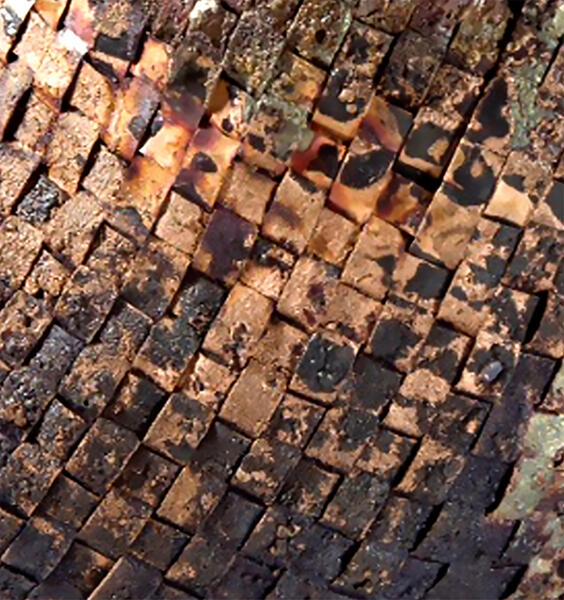 Tea Bowl No.19, detail.jpgDetail of a silver-oxide fired woven basket. Recycled materials, woven copper, fired silver oxide patina, polychrome.
Tea Bowl No.19, detail.jpgDetail of a silver-oxide fired woven basket. Recycled materials, woven copper, fired silver oxide patina, polychrome. -
 Tea Bowl Diagonal No.19I always wanted to create a crusty, dark, variegated surface on my baskets, such as potters created with a wood-firing kiln. I spent eight years experimenting. Never finding the surface, I sought. One summer, while working as a teaching assistant in Burnsville, North Carolina, I visited a local welding shop searching for a bit of brazing rod. As is my habit in a new shop, I wandered about and looked at what they were doing. A fellow was busily grinding a large copper kettle he had just welded a patch on. What he was so busy removing was the exact surface I had been working so hard to achieve. I asked him what he used for the patch, and he pointed me to an old box of the tarnished rod. He said, "you're welcome to take this shit with you. I hate it." It was as easy as that. Recycled materials, woven copper, fired silver oxide patina 14" x 12.75" x 14.5."
Tea Bowl Diagonal No.19I always wanted to create a crusty, dark, variegated surface on my baskets, such as potters created with a wood-firing kiln. I spent eight years experimenting. Never finding the surface, I sought. One summer, while working as a teaching assistant in Burnsville, North Carolina, I visited a local welding shop searching for a bit of brazing rod. As is my habit in a new shop, I wandered about and looked at what they were doing. A fellow was busily grinding a large copper kettle he had just welded a patch on. What he was so busy removing was the exact surface I had been working so hard to achieve. I asked him what he used for the patch, and he pointed me to an old box of the tarnished rod. He said, "you're welcome to take this shit with you. I hate it." It was as easy as that. Recycled materials, woven copper, fired silver oxide patina 14" x 12.75" x 14.5."
Our Declining Woodlands
The decline of our native woodlands is thought to had been caused by invasive chemicals or direct persecution. Recent research has revealed that while chemicals and topsoil removal are harmful in actuality, our remaining woodlands are rapidly declining due to soil-based processes.
Clear cutting the forest protects fertile soil; overgrazing of the remaining native vegetation by out-of-control populations of hoofed ruminants while water storage shifts from within the ground to surface reservoirs has profoundly impacted below-ground decomposer communities. This action has led to fewer ground-dwelling invertebrate prey and reduced numbers of insectivores. This hypothesis is congruent with previous findings, explaining ground-foraging insectivores' susceptibility to changing land-use, the sensitivity of native woodlands to the stress of drought, and the decreased resilience of our remaining woods due to lower ground litter and greater sensitivity to eutrophication.
IOW: Walking catfish, kudzu, oriental bittersweet, and DDT, while destructive, are not the sole cause of our declining native woodlands. McMansions, deer, and draining of groundwater negatively affect the soils fungi and bacteria lead to the eventual decline in the population of anything above ground, from worms and insects to turtles and larger animals. Additionally, we are killing our insect populations, including the honeybees, in part because we insist on raking up every single leaf that falls each autumn and draining chemical and sewage waste from our land into our water. The chemical waste causes explosive growth of some water plants, killing terrestrial and aquatic life due to a lack of oxygen.
What does this have to do with a plaited copper baskets?
Nothing? Well, almost nothing.
The woodland surrounding my home has served as the inspiration for a body of work I have been actively pursuing since the late 1980s.
The colors of the oxygen-deprived water adjacent to the remnant of a near-by stream is a patchwork of magnificent cerulean blues and chromate greens. Dead trees moistened by the summer's morning rain stand starkly black against the leafless background of the cobalt blue sky. Sienna, umber, and grey stumps remain, roots firmly planted, their age defining rings a time point of Delaunay marks and lines. The golden swirl of Dutchman's pipe set against the afflicted, azo-yellow foliage of a black walnut sapling grabs my attention.
These scenes filled with the imperfections of disease, decay and disregard for the environment provide a robustly compelling visual essay, not one good for the planet's health but strangely beautiful none the less. These images have guided my work for decades.
-
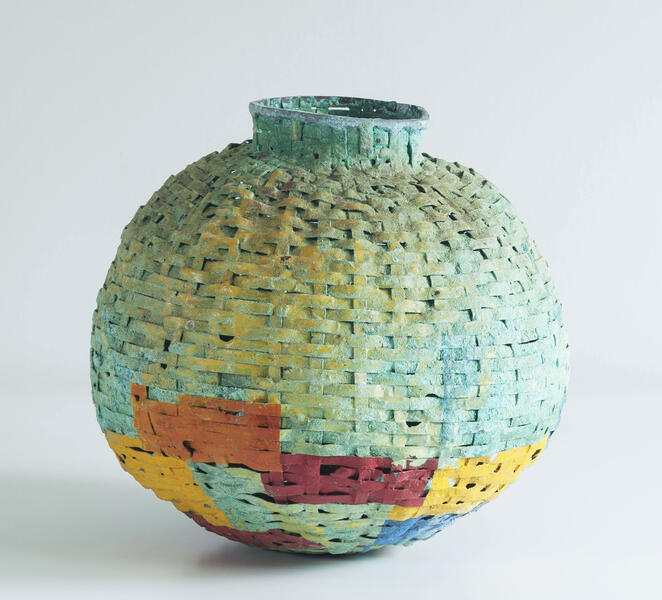 Blackwater Bulb No8Blackwater Wild Life refuge on Marylands Eastern shore is most famously known as the temporary home to migrating waterfowl who travel the Atlantic Flyway. The sanctuary, a mix of tidal wetlands, open fields, and mixed forest provides abundant opportunities to experience the unusual landscape and birds. The name blackwater comes is a tribute to the water's deep red-brown color, the result of the tannin that is deposited from nearby peat bogs. Over the years I have taken 100's of photographs and drawn an equal number of sketches recording the ever-changing landscape employing those as the basis of muchof my work. Recycled materials, woven copper, chemical patina, polychrome 10.75” x 8.5" x 8.5"
Blackwater Bulb No8Blackwater Wild Life refuge on Marylands Eastern shore is most famously known as the temporary home to migrating waterfowl who travel the Atlantic Flyway. The sanctuary, a mix of tidal wetlands, open fields, and mixed forest provides abundant opportunities to experience the unusual landscape and birds. The name blackwater comes is a tribute to the water's deep red-brown color, the result of the tannin that is deposited from nearby peat bogs. Over the years I have taken 100's of photographs and drawn an equal number of sketches recording the ever-changing landscape employing those as the basis of muchof my work. Recycled materials, woven copper, chemical patina, polychrome 10.75” x 8.5" x 8.5" -
 Blackwater Hydria No.5My wife and I visit the Blackwater Wild Life refuge hoping to glimpse the visiting waterfowl and resident eagles. The sanctuary a mix of marsh, woodland, open water, and ever-changing landmasses provides many opportunities to record the expansive landscape of ever-changing shrub islands, inlets, and open water. I originally believed that Blck water was a native American name but later discovered that the source of the name blackwater comes from the water's deep red-brown color, the result of the tannin in the nearby peat bogs. 17" x 14.5” x 14”
Blackwater Hydria No.5My wife and I visit the Blackwater Wild Life refuge hoping to glimpse the visiting waterfowl and resident eagles. The sanctuary a mix of marsh, woodland, open water, and ever-changing landmasses provides many opportunities to record the expansive landscape of ever-changing shrub islands, inlets, and open water. I originally believed that Blck water was a native American name but later discovered that the source of the name blackwater comes from the water's deep red-brown color, the result of the tannin in the nearby peat bogs. 17" x 14.5” x 14” -
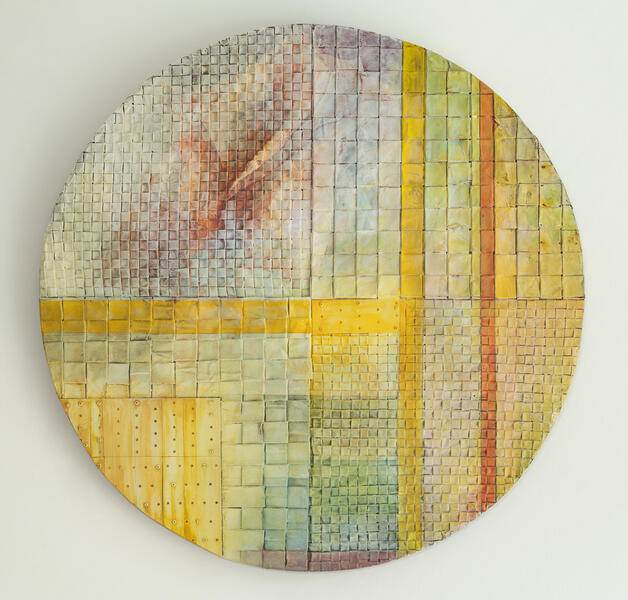 Walled Garden-Stagnant Spring on BeaverbrookRecycled materials, woven copper, chemical patina, polychrome 36" x 36" x 1.5"
Walled Garden-Stagnant Spring on BeaverbrookRecycled materials, woven copper, chemical patina, polychrome 36" x 36" x 1.5" -
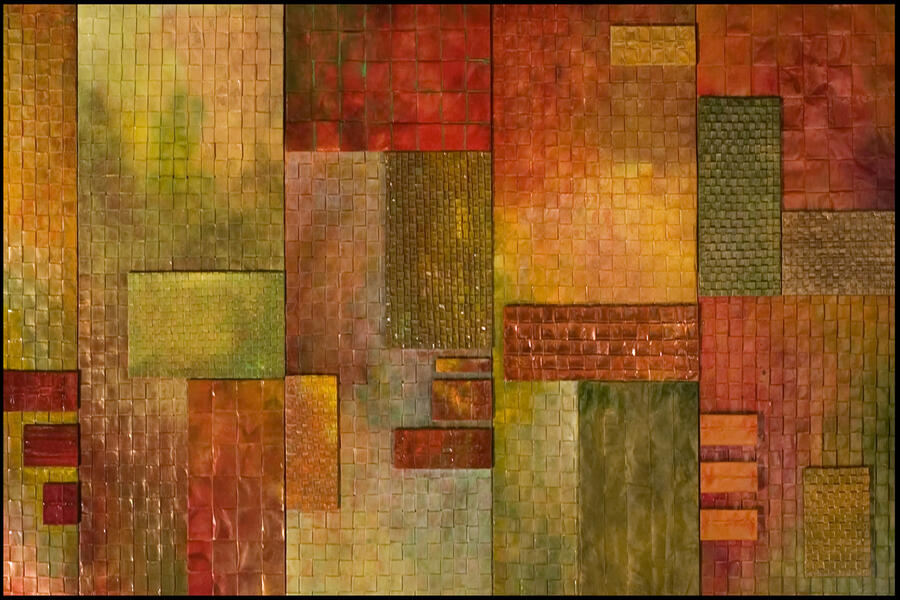 Sycamore.jpgRecycled materials, woven copper, chemical patina, polychrome 110” x 51” x 2”
Sycamore.jpgRecycled materials, woven copper, chemical patina, polychrome 110” x 51” x 2” -
 River Birch No.1Recycled materials, woven copper, chemical patina, polychrome 10” x 10.5” x 8”
River Birch No.1Recycled materials, woven copper, chemical patina, polychrome 10” x 10.5” x 8” -
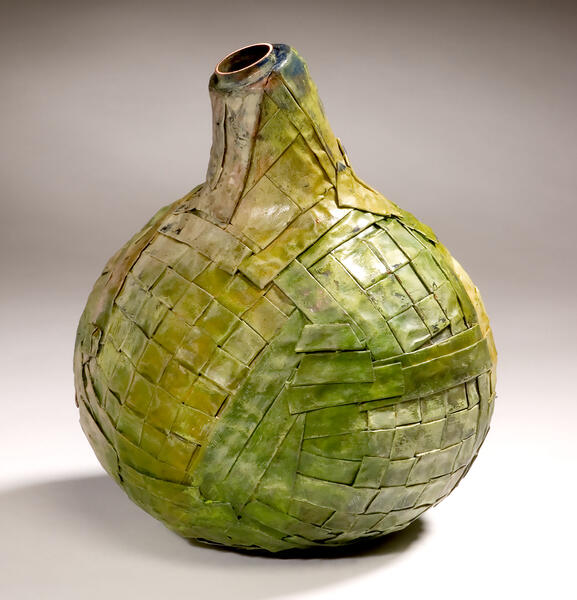 Seckel PearWhen I was in high school, I walked by a seckel pear tree every day as I walked to and from the bus stop. It was on the right side of the road, up a slight incline, huge, its bark striated with fungus, grey, scared, arthritically gnarled, pitted. The pears were never even close to perfect, but each year I looked forward to that time in spring when I could harvest one of the slightly under-ripe pears as my afternoon snack. Recycled materials, woven copper, turned wood substructure, chemical patina, polychrome 7” x 9" x 7”
Seckel PearWhen I was in high school, I walked by a seckel pear tree every day as I walked to and from the bus stop. It was on the right side of the road, up a slight incline, huge, its bark striated with fungus, grey, scared, arthritically gnarled, pitted. The pears were never even close to perfect, but each year I looked forward to that time in spring when I could harvest one of the slightly under-ripe pears as my afternoon snack. Recycled materials, woven copper, turned wood substructure, chemical patina, polychrome 7” x 9" x 7” -
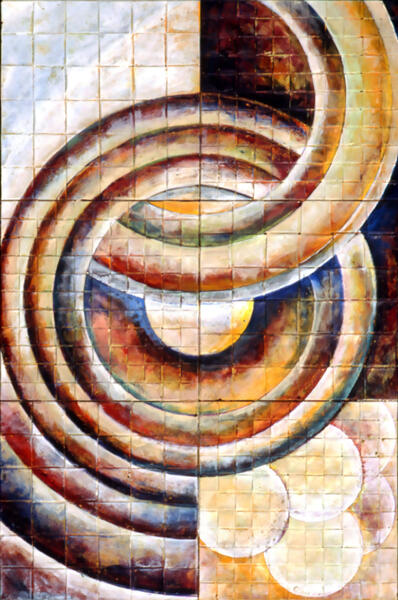 False Growth Rings-Timepoint Spring.Occasionally a plant will exhibit a false growth ring. This is an annual ring that does not reflect an entire season’s growth or that does not extend entirely around the plant's circumference. False annual rings are the result of unusual climatic conditions such as especially harsh, dry or cold winters. Recycled materials, woven copper, chemical patina, polychrome 24” x 36” x 2”
False Growth Rings-Timepoint Spring.Occasionally a plant will exhibit a false growth ring. This is an annual ring that does not reflect an entire season’s growth or that does not extend entirely around the plant's circumference. False annual rings are the result of unusual climatic conditions such as especially harsh, dry or cold winters. Recycled materials, woven copper, chemical patina, polychrome 24” x 36” x 2” -
 Annual Rings-Timepoints SummerGrowth rings mark the degree of growth added in a single season to a woody plant. Growth rings tell the story of the plant's lifetime. When it was well fed; when it had sufficient water; when lightning struck the plant or a brush fire scorch its bark; how old the plant is and what history it witnessed can all be read in the annual growth Recycled materials, copper, chemical patina, polychrome 24” x 36” x 2”
Annual Rings-Timepoints SummerGrowth rings mark the degree of growth added in a single season to a woody plant. Growth rings tell the story of the plant's lifetime. When it was well fed; when it had sufficient water; when lightning struck the plant or a brush fire scorch its bark; how old the plant is and what history it witnessed can all be read in the annual growth Recycled materials, copper, chemical patina, polychrome 24” x 36” x 2” -
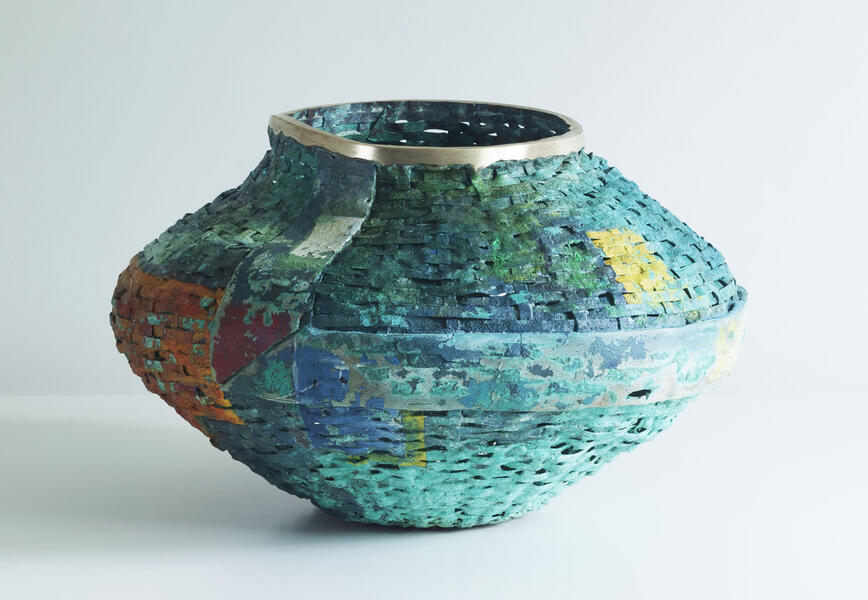 Blackwater No.3My wife and I periodically visit the Blackwater Wild Life refuge to catch a glimpse of the visiting waterfowl and the resident eagles that call the sanctuary home. The sanctuary is a mix of marsh, woodland, open water, and ever-changing landmasses that provide interest and opportunity to record with photographs and sketches the landscape, birds, and mammals that call the refuge home The name blackwater comes from the water's deep red-brown color, the result of the tannin in the nearby peat boggy soil staining the water as it drains into the marshland. Plaited copper, bronze rim. Multiple applications of chemical patinas. Polychrome. 9.75" x 13.5" x 14"
Blackwater No.3My wife and I periodically visit the Blackwater Wild Life refuge to catch a glimpse of the visiting waterfowl and the resident eagles that call the sanctuary home. The sanctuary is a mix of marsh, woodland, open water, and ever-changing landmasses that provide interest and opportunity to record with photographs and sketches the landscape, birds, and mammals that call the refuge home The name blackwater comes from the water's deep red-brown color, the result of the tannin in the nearby peat boggy soil staining the water as it drains into the marshland. Plaited copper, bronze rim. Multiple applications of chemical patinas. Polychrome. 9.75" x 13.5" x 14" -
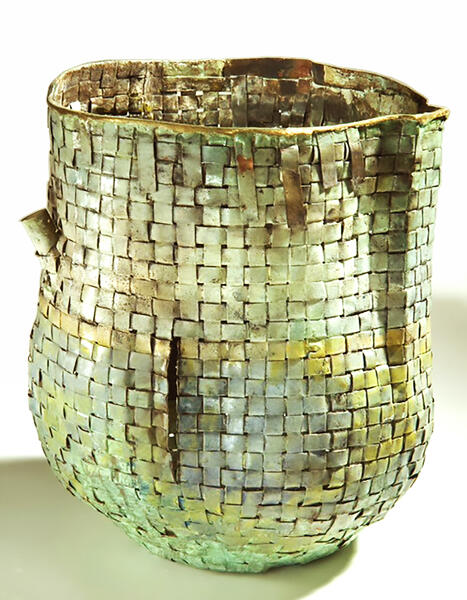 Bole No.3I never cut trees stump down to the ground, choosing instead to leave a bole of 5' or more to remain. Boles mature more slowly than wood of similar girth left to decay on the ground, and a bole provides a handy home for insects, birds, mammals, and a convenient seat when I want to rest in the woodland. This plaited copper bole began life as dusty, red-orange copper. The patina continually changing the color evolves guided by the metal's interactions with the environment. Recycled material, copper, chemical patina, polychrome 20" x 14" x15"
Bole No.3I never cut trees stump down to the ground, choosing instead to leave a bole of 5' or more to remain. Boles mature more slowly than wood of similar girth left to decay on the ground, and a bole provides a handy home for insects, birds, mammals, and a convenient seat when I want to rest in the woodland. This plaited copper bole began life as dusty, red-orange copper. The patina continually changing the color evolves guided by the metal's interactions with the environment. Recycled material, copper, chemical patina, polychrome 20" x 14" x15"
Three Eyewitnesses
1. My wife just left to pick up trash on Beaver Dam Road. She's meeting her friend Molly who is studying to become a Master Naturalist. "It's disgusting that people throw their trash on the road rather than in cans or at the dump." ( The county waste dump is a 5-minute drive from where they will be collecting trash today.)
2. Peering from the leaves of a cinnamon fern, a green treefrog comfortably surveys its domain. Many ferns create a reservoir, a tiny pond at the base of their leaves, beneath an otherwise dry forest canopy.
3. In a bid to foil predators, the eastern box turtle can withdraw surrounded by its hard shell, making it difficult for a predator to attack. The ploy generally foils all predators but one—humans. Loss of habitat, collisions with cars, and illegal trade are the three most common causes of the diminishing box turtle population.
A woodlands beauty is the result of its many naturally occurring and diverse, interlocking habitats. Forest floor, understory, canopy, and emergent layers along with a wide variety of animals and insects fit together perfectly like a 100,000 piece jigsaw puzzle, each piece's necessity and place determined by the soil, light, water.
Scores of vertebrates and invertebrates watch the puzzle as they adapt and grow, always trying to create beauty while absorbing our trash and environmental abuse. Sometimes we help but often, like the turtle, we pull inside our shells and hope for the best.
2. Peering from the leaves of a cinnamon fern, a green treefrog comfortably surveys its domain. Many ferns create a reservoir, a tiny pond at the base of their leaves, beneath an otherwise dry forest canopy.
3. In a bid to foil predators, the eastern box turtle can withdraw surrounded by its hard shell, making it difficult for a predator to attack. The ploy generally foils all predators but one—humans. Loss of habitat, collisions with cars, and illegal trade are the three most common causes of the diminishing box turtle population.
A woodlands beauty is the result of its many naturally occurring and diverse, interlocking habitats. Forest floor, understory, canopy, and emergent layers along with a wide variety of animals and insects fit together perfectly like a 100,000 piece jigsaw puzzle, each piece's necessity and place determined by the soil, light, water.
Scores of vertebrates and invertebrates watch the puzzle as they adapt and grow, always trying to create beauty while absorbing our trash and environmental abuse. Sometimes we help but often, like the turtle, we pull inside our shells and hope for the best.
-
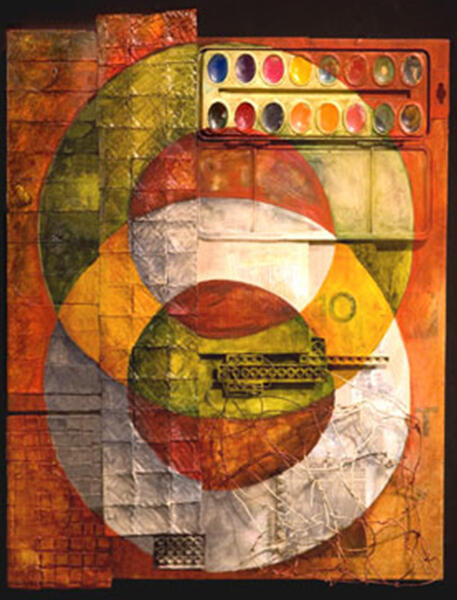 KinderTrash gathered from a children's play area in a local state park. Children learn from their elders. If grown-ups can't find the time or inclination to dispose of waste properly, how can we expect the next generation to do so? Recycled materials, woven copper, steel wire, chemical patina, polychrome 18" x 24" x 2".
KinderTrash gathered from a children's play area in a local state park. Children learn from their elders. If grown-ups can't find the time or inclination to dispose of waste properly, how can we expect the next generation to do so? Recycled materials, woven copper, steel wire, chemical patina, polychrome 18" x 24" x 2". -
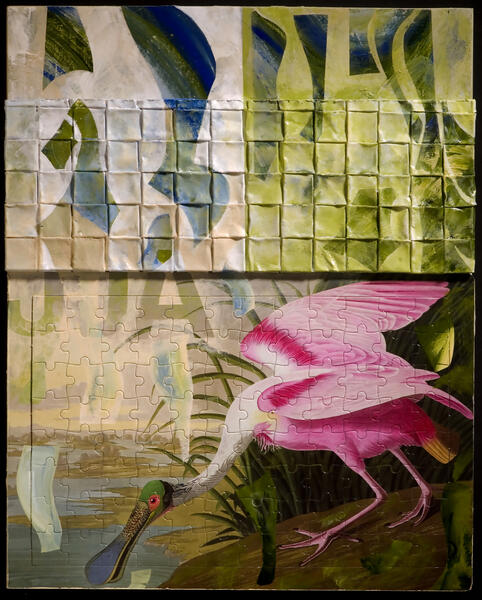 Audubon"John James Audubon (born Jean-Jacques Rabin; April 26, 1785 – January 27, 1851) was an American ornithologist, naturalist, and painter. His combined interests in art and ornithology turned into a plan to make a complete pictorial record of all the bird species of North America." ( Wikipedia) What wasn't mentioned was that Audubon shot the birds he painted and stuffed them to allow closer examination. Taxidermy was considered acceptable and appropriate in the early 1830s. The extinction of a species was almost unheard of then. Our planet faces possible death in the future. Maybe it is time we thought about changing our approach to the environment around us. Recycled materials, woven copper, steel wire, chemical patina, polychrome 18” x 24” x 2”
Audubon"John James Audubon (born Jean-Jacques Rabin; April 26, 1785 – January 27, 1851) was an American ornithologist, naturalist, and painter. His combined interests in art and ornithology turned into a plan to make a complete pictorial record of all the bird species of North America." ( Wikipedia) What wasn't mentioned was that Audubon shot the birds he painted and stuffed them to allow closer examination. Taxidermy was considered acceptable and appropriate in the early 1830s. The extinction of a species was almost unheard of then. Our planet faces possible death in the future. Maybe it is time we thought about changing our approach to the environment around us. Recycled materials, woven copper, steel wire, chemical patina, polychrome 18” x 24” x 2” -
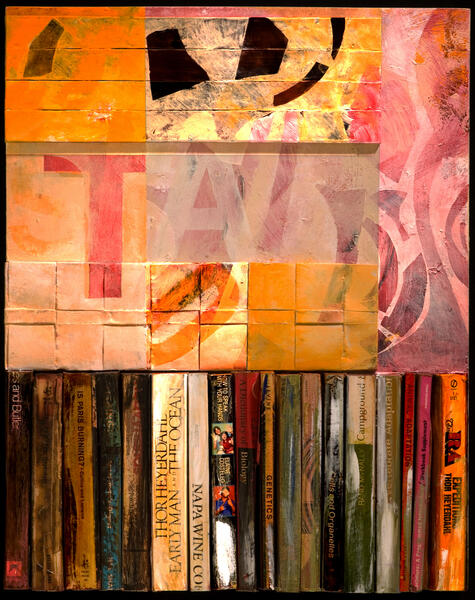 Heyerdahl"Thor Heyerdahl was a Norwegian adventurer and ethnographer with a background in zoology, botany, and geography. Heyerdahl is notable for his Kon-Tiki expedition in 1947, in which he sailed 8,000 km across the Pacific Ocean in a handbuilt raft from South America to the Tuamotu Islands." ( Wikipedia) Heyerdahl repeatedly risked his life sailing across the Pacific in a raft, proving Trans-cultural diffusion between ancient peoples was possible. Heyerdahl accomplished this with rudimentary tools, gathered materials, and a few volunteers. Today, from the comfort of a desk chair with computer technology and the internet, ideas and technology-shared between individuals and entire countries should be simple. So, why can't the nations of the world aggressively address the issue of global warming? Recycled materials, woven copper, steel wire, chemical patina, polychrome 18" x 24" x 2".
Heyerdahl"Thor Heyerdahl was a Norwegian adventurer and ethnographer with a background in zoology, botany, and geography. Heyerdahl is notable for his Kon-Tiki expedition in 1947, in which he sailed 8,000 km across the Pacific Ocean in a handbuilt raft from South America to the Tuamotu Islands." ( Wikipedia) Heyerdahl repeatedly risked his life sailing across the Pacific in a raft, proving Trans-cultural diffusion between ancient peoples was possible. Heyerdahl accomplished this with rudimentary tools, gathered materials, and a few volunteers. Today, from the comfort of a desk chair with computer technology and the internet, ideas and technology-shared between individuals and entire countries should be simple. So, why can't the nations of the world aggressively address the issue of global warming? Recycled materials, woven copper, steel wire, chemical patina, polychrome 18" x 24" x 2". -
 Callow AveAssorted flotsam collected between Whitelock Street and 2200 Callow Avenue immediately after the Whitelock Street corridor was bulldozed to force dug sellers out of the neighborhood; copper, steel, mosaic tile, steel wire, discarded bullnose pliers, steel plates, and wood. 72” x 30” x 4”
Callow AveAssorted flotsam collected between Whitelock Street and 2200 Callow Avenue immediately after the Whitelock Street corridor was bulldozed to force dug sellers out of the neighborhood; copper, steel, mosaic tile, steel wire, discarded bullnose pliers, steel plates, and wood. 72” x 30” x 4” -
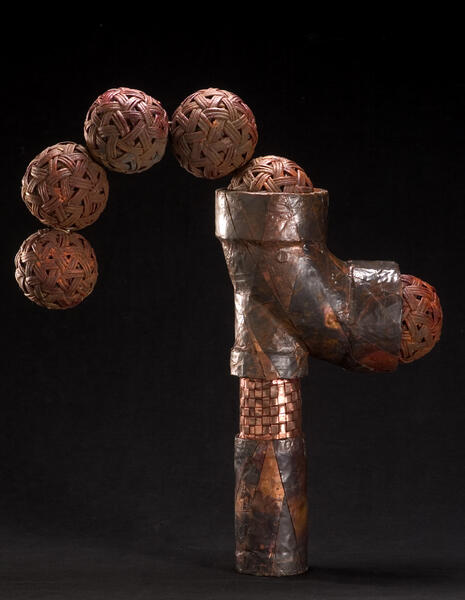 GIGO-ContinuumGIGO. Garbage in: Garbage out. It couldn't be simpler. The quality of input determines the quality of the output. If we poison our groundwater, eventually, we poison ourselves. If we fill our oceans with plastic and other waste products, we kill the sea creatures and sea vegetables that provide us with food. If we continue to cut down our woodlands and burn fossil fuels, we create greenhouse house gases, which increases the earth's temperature. It is a continuum. GIGO. Recycled material, waste pipe recovered from a stream, woven copper, chemical patina, polychrome 21" x 18" x 6."
GIGO-ContinuumGIGO. Garbage in: Garbage out. It couldn't be simpler. The quality of input determines the quality of the output. If we poison our groundwater, eventually, we poison ourselves. If we fill our oceans with plastic and other waste products, we kill the sea creatures and sea vegetables that provide us with food. If we continue to cut down our woodlands and burn fossil fuels, we create greenhouse house gases, which increases the earth's temperature. It is a continuum. GIGO. Recycled material, waste pipe recovered from a stream, woven copper, chemical patina, polychrome 21" x 18" x 6." -
 Red White BluePatriotism and pollution do not need to walk hand in hand. Recycled materials, woven copper, steel wire, chemical patina, polychrome 72” x 14” x 2.”
Red White BluePatriotism and pollution do not need to walk hand in hand. Recycled materials, woven copper, steel wire, chemical patina, polychrome 72” x 14” x 2.” -
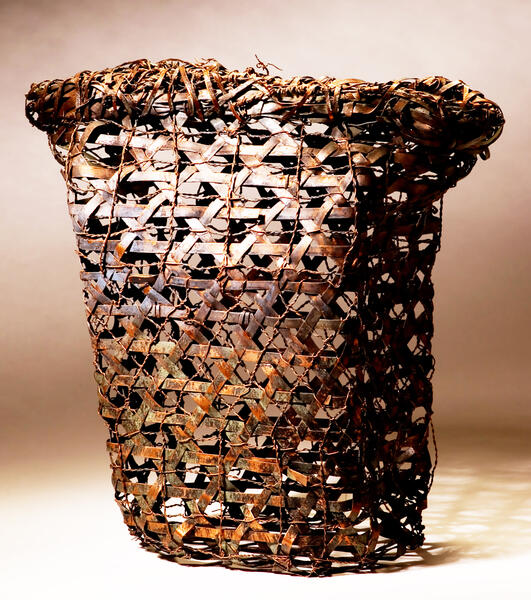 Box TurtleWhen I was young, finding a box turtle or looking at fireflies on a summer night was one of life's great joys. I never see live box turtles anymore. But, I found a turtle's carapace half-buried in mud and concealed by stilt grass in the field that abuts the Beaverbrook. The beautiful coloring of the shells covering was long gone, but the carapace's plates' hexagonal pattern was still evident. Lightning bugs and turtles are few and far between; loss of habitat to ever-expanding suburbs, light pollution, pollution of the water, collision with cars, and illegal trade has dramatically diminished these and many other species. Six unit, hexagonal plaiting with chemical patina, 13" x 9" x 8".
Box TurtleWhen I was young, finding a box turtle or looking at fireflies on a summer night was one of life's great joys. I never see live box turtles anymore. But, I found a turtle's carapace half-buried in mud and concealed by stilt grass in the field that abuts the Beaverbrook. The beautiful coloring of the shells covering was long gone, but the carapace's plates' hexagonal pattern was still evident. Lightning bugs and turtles are few and far between; loss of habitat to ever-expanding suburbs, light pollution, pollution of the water, collision with cars, and illegal trade has dramatically diminished these and many other species. Six unit, hexagonal plaiting with chemical patina, 13" x 9" x 8". -
 What If Pax“In 1945, peace broke out. It was the end of the Joke. Joke warfare was banned at a special session of the Geneva Convention, and in 1950 the last remaining copy of the Joke was laid to rest here in the Berkshire countryside, never to be told again.” Monty Python’s Flying Circus Peace throughout the world shouldn’t be a joke. Recycled materials, woven copper, steel wire, chemical patina, polychrome
What If Pax“In 1945, peace broke out. It was the end of the Joke. Joke warfare was banned at a special session of the Geneva Convention, and in 1950 the last remaining copy of the Joke was laid to rest here in the Berkshire countryside, never to be told again.” Monty Python’s Flying Circus Peace throughout the world shouldn’t be a joke. Recycled materials, woven copper, steel wire, chemical patina, polychrome -
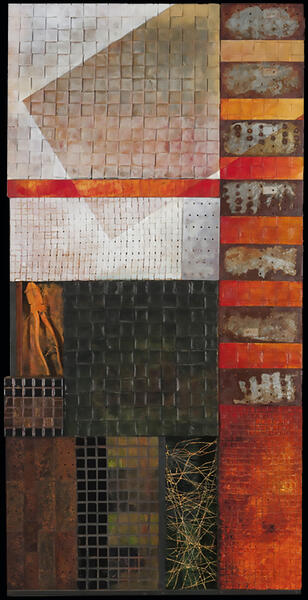 2200 Callow AveFlotsam collected between Whitelock Street and 2200 Callow Avenue immediately after Whitelock was bulldozed to force dug sellers out of the neighborhood; copper, steel, mosaic tile, steel wire, discarded pliers, steel plates, and wood. 96" x 36" x 4"
2200 Callow AveFlotsam collected between Whitelock Street and 2200 Callow Avenue immediately after Whitelock was bulldozed to force dug sellers out of the neighborhood; copper, steel, mosaic tile, steel wire, discarded pliers, steel plates, and wood. 96" x 36" x 4" -
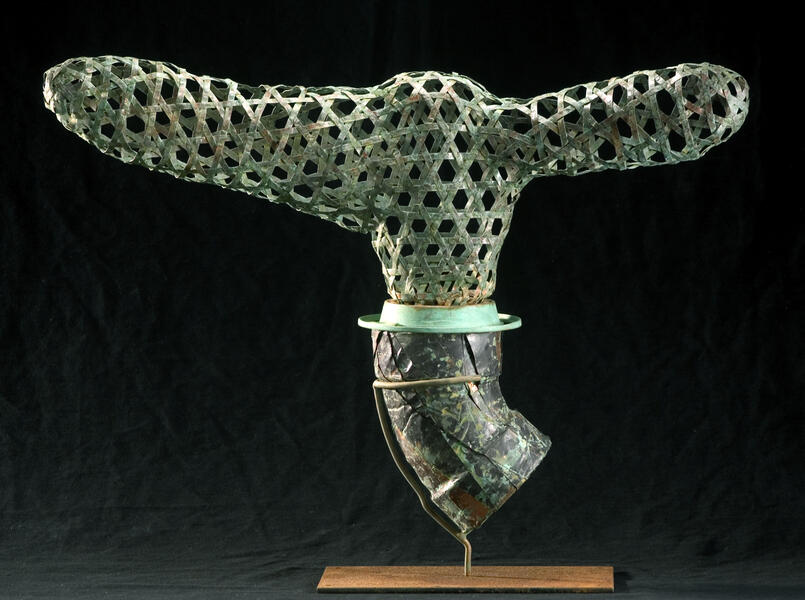 GIGO- PipeGarbage In-Garbage Out Flotsam collected between Whitelock Street and 2200 Callow Avenue immediately after Whitelock was bulldozed to force dug sellers out of the neighborhood; Recycled materials, disused sewer pipe, copper sheet, plaited copper, steel, chemical patina.
GIGO- PipeGarbage In-Garbage Out Flotsam collected between Whitelock Street and 2200 Callow Avenue immediately after Whitelock was bulldozed to force dug sellers out of the neighborhood; Recycled materials, disused sewer pipe, copper sheet, plaited copper, steel, chemical patina.
Context-sensitivity
Context-sensitivity refers to the proposition that there exists a disparity between understanding a concept in isolation and understanding the same idea or object when used in context.
Ex. A vast difference exists between a golden bamboo rhizome's beauty when employed as the model for a sculpture and that of planting that same rhizome in your garden. Golden bamboo rhizomes are beautiful to look at but invasive and highly destructive in the environment
I was introduced to bulbs 40 years ago when I ordered a few from a catalog as a new woodland gardener. Anxiously awaiting the latest additions to my garden, when the box arrived, my initial reaction wasn't, "I can't wait to see a river of daffodils next spring." Instead, my first reaction was, these bulbs are beautiful sculptural forms. The architecturally abstract corms, bulbs, tubers, and rhizomes provided an immediate jump-start to my sculptural basket making, which up to that point hadn't strayed too far from traditional basketry forms.
Brief background:
Bulbs, corms, tubers, and rhizomes all fall under the scientific umbrella of geophytes.
True bulbs are layered like an onion.
Corms are solid, appearing in nature as a swollen, underground plant stem.
Tubers, a potato is a tuber, are solid with multiple budding points commonly referred to as eyes. If you plant an individual bud (eye), you can grow a new plant. This ability to divide a tuber when creating new plants is not shared with either corms or bulbs.
Rhizomes are modified, swollen stems that extend horizontally from the parent plant. Rhizomes look roots but aren't. Like a tuber, a rhizome can be divided to create new plants. Any small piece of a rhizome can, in most instances, grow into a new plant.
The layered construction and the curvaceous outlines of bulbs, corms, and tubers are ideal for the slow, progressive layering utilized with the plaiting and twinging of traditional basketry techniques. Additionally, geophytes' colors harmonize with the soft, naturally developed patinas inherent in traditional patina techniques.
Ex. A vast difference exists between a golden bamboo rhizome's beauty when employed as the model for a sculpture and that of planting that same rhizome in your garden. Golden bamboo rhizomes are beautiful to look at but invasive and highly destructive in the environment
I was introduced to bulbs 40 years ago when I ordered a few from a catalog as a new woodland gardener. Anxiously awaiting the latest additions to my garden, when the box arrived, my initial reaction wasn't, "I can't wait to see a river of daffodils next spring." Instead, my first reaction was, these bulbs are beautiful sculptural forms. The architecturally abstract corms, bulbs, tubers, and rhizomes provided an immediate jump-start to my sculptural basket making, which up to that point hadn't strayed too far from traditional basketry forms.
Brief background:
Bulbs, corms, tubers, and rhizomes all fall under the scientific umbrella of geophytes.
True bulbs are layered like an onion.
Corms are solid, appearing in nature as a swollen, underground plant stem.
Tubers, a potato is a tuber, are solid with multiple budding points commonly referred to as eyes. If you plant an individual bud (eye), you can grow a new plant. This ability to divide a tuber when creating new plants is not shared with either corms or bulbs.
Rhizomes are modified, swollen stems that extend horizontally from the parent plant. Rhizomes look roots but aren't. Like a tuber, a rhizome can be divided to create new plants. Any small piece of a rhizome can, in most instances, grow into a new plant.
The layered construction and the curvaceous outlines of bulbs, corms, and tubers are ideal for the slow, progressive layering utilized with the plaiting and twinging of traditional basketry techniques. Additionally, geophytes' colors harmonize with the soft, naturally developed patinas inherent in traditional patina techniques.
-
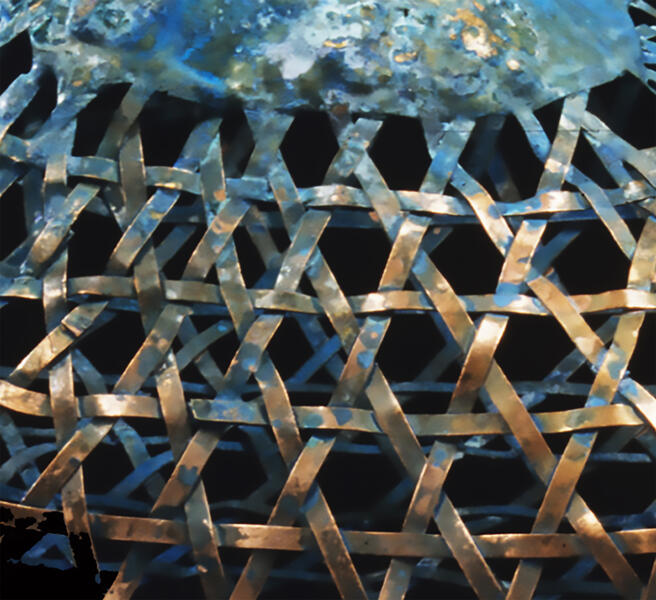 Tulip Bulbdetail-Tulip Bulb plaited copper, six-unit diagonal hex weave, chemical patina, ammonia fuming 9.5" x 9" x 5"
Tulip Bulbdetail-Tulip Bulb plaited copper, six-unit diagonal hex weave, chemical patina, ammonia fuming 9.5" x 9" x 5" -
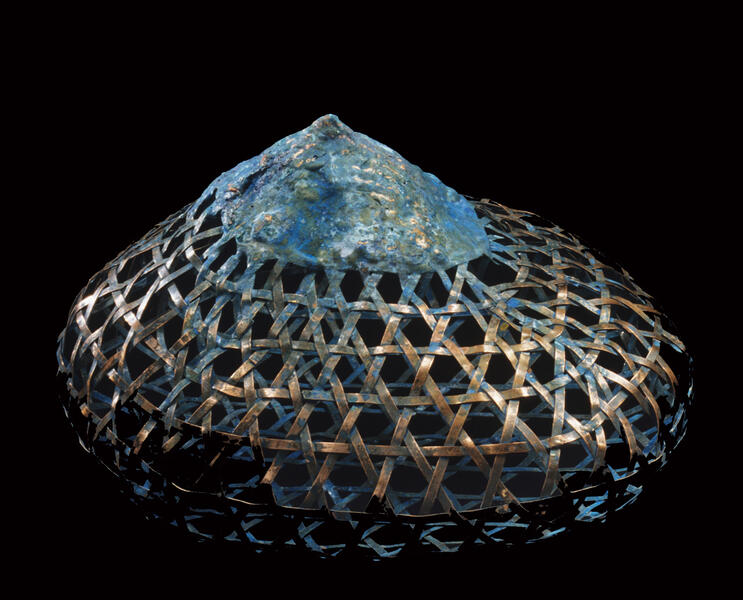 Bulb-TulipI love the shape of a tulip bulb. A tiny tagine of genetic power built of layer upon layer of nutritional material all encased in a paper-brown wrapper. Perfection. Plaited copper, six-unit diagonal hex weave, chemical patina, ammonia fuming 9.5" x 9" x 5"
Bulb-TulipI love the shape of a tulip bulb. A tiny tagine of genetic power built of layer upon layer of nutritional material all encased in a paper-brown wrapper. Perfection. Plaited copper, six-unit diagonal hex weave, chemical patina, ammonia fuming 9.5" x 9" x 5" -
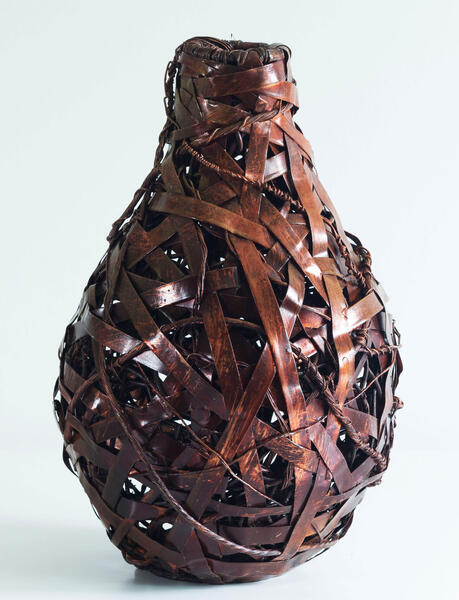 Tangled Root BulbImagine trying to transplant a large group of established geophytes that have lived in one location for several years. Multiplying, they have grown large, packing themselves like sardines in a tin, surrounded by fibrous roots, inconveniently situated rocks, and invasive rhizomes. Plaited copper, chemical patina 13.75" x 8.5" x 8.5."
Tangled Root BulbImagine trying to transplant a large group of established geophytes that have lived in one location for several years. Multiplying, they have grown large, packing themselves like sardines in a tin, surrounded by fibrous roots, inconveniently situated rocks, and invasive rhizomes. Plaited copper, chemical patina 13.75" x 8.5" x 8.5." -
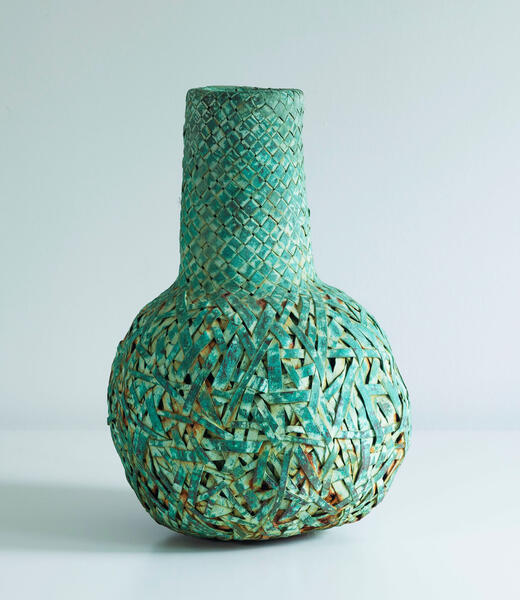 Bulb No.2Six unit, hexagonal plaited steel with over weave of copper strip, segued to diagonal plaited copper form. Chemical patina 13.50" x 9" x 9"
Bulb No.2Six unit, hexagonal plaited steel with over weave of copper strip, segued to diagonal plaited copper form. Chemical patina 13.50" x 9" x 9" -
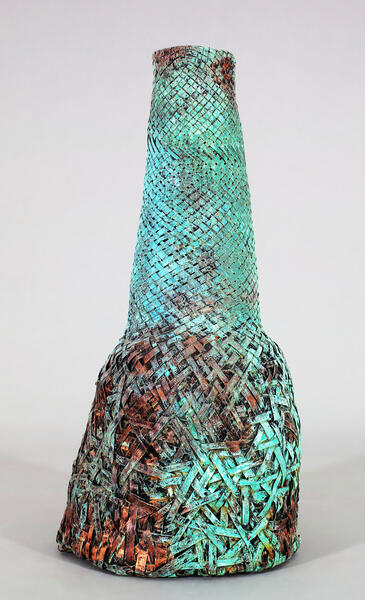 RampA ramp is a deliciously odiferous member of the onion family. A bulb at its base a ramp throws up green stalks with broad leaves that eventually unfurl. Smaller than a scallion, with a pungent garlic-onion taste and smell, I thought they would be perfect on a south-facing slope, partially shaded, with good drainage in my new woodland. Unfortunately, unlike sculpture, where I can exercise some control over my materials, plants don’t always cooperate. Plaited copper, 6 unit hex weave ( encased in copper strips) transformed into a diagonal weave. Chemical patina 21” x 13.75” x 14.50.”
RampA ramp is a deliciously odiferous member of the onion family. A bulb at its base a ramp throws up green stalks with broad leaves that eventually unfurl. Smaller than a scallion, with a pungent garlic-onion taste and smell, I thought they would be perfect on a south-facing slope, partially shaded, with good drainage in my new woodland. Unfortunately, unlike sculpture, where I can exercise some control over my materials, plants don’t always cooperate. Plaited copper, 6 unit hex weave ( encased in copper strips) transformed into a diagonal weave. Chemical patina 21” x 13.75” x 14.50.” -
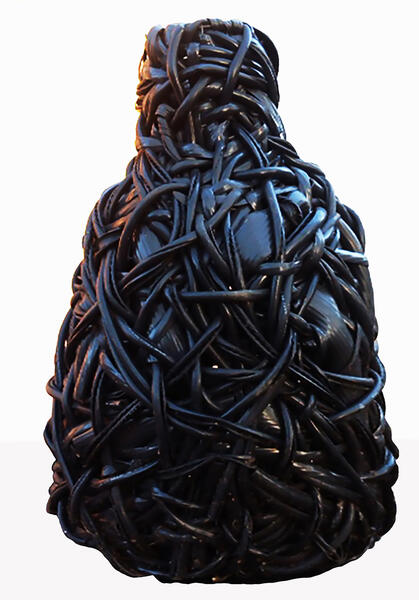 Black Bulb -TulipSix unit hex weave in steel overlaid with plaited telephone wire sheathing 19" x 13" x 12"
Black Bulb -TulipSix unit hex weave in steel overlaid with plaited telephone wire sheathing 19" x 13" x 12" -
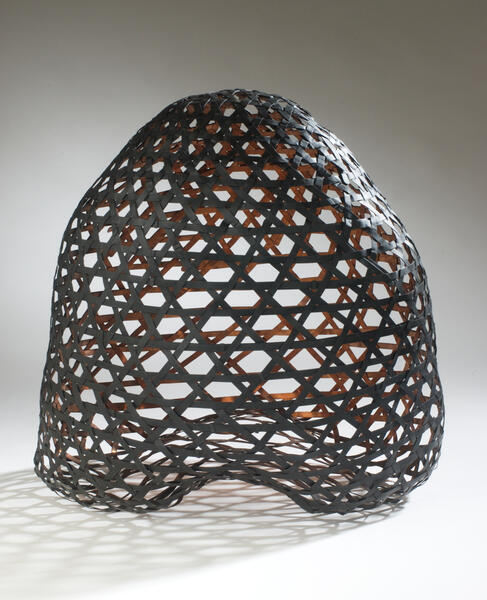 Sunchoke TuberA Sunchoke is a beautiful plant that sends up strong stems several feet in the air with yellow daisy like flowers. The tuber at its base is pale brown, varied shapes and sizes, deliciously edible, and appears, at least to me to have a hexagonal webbing on its surface. Six unit, hexagonal weave. Chemical patina. 20" x 20" x 15"
Sunchoke TuberA Sunchoke is a beautiful plant that sends up strong stems several feet in the air with yellow daisy like flowers. The tuber at its base is pale brown, varied shapes and sizes, deliciously edible, and appears, at least to me to have a hexagonal webbing on its surface. Six unit, hexagonal weave. Chemical patina. 20" x 20" x 15" -
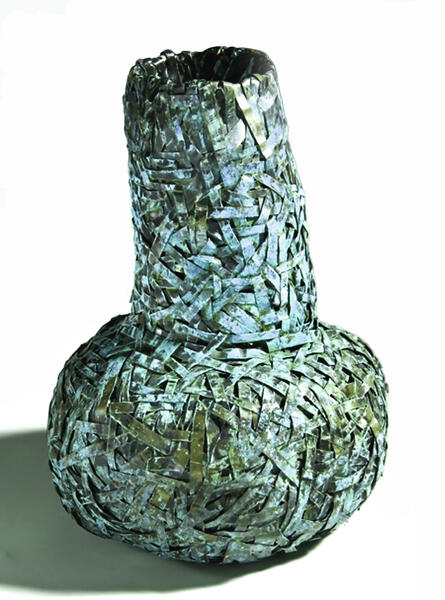 Bulb- NarcissusSix unit hexagonal weave in steel with over-weave of recycled copper 1/4" strips and wire. Chemical patina with Liver of sulfate fuming. 21" x 14" x 13.5"
Bulb- NarcissusSix unit hexagonal weave in steel with over-weave of recycled copper 1/4" strips and wire. Chemical patina with Liver of sulfate fuming. 21" x 14" x 13.5" -
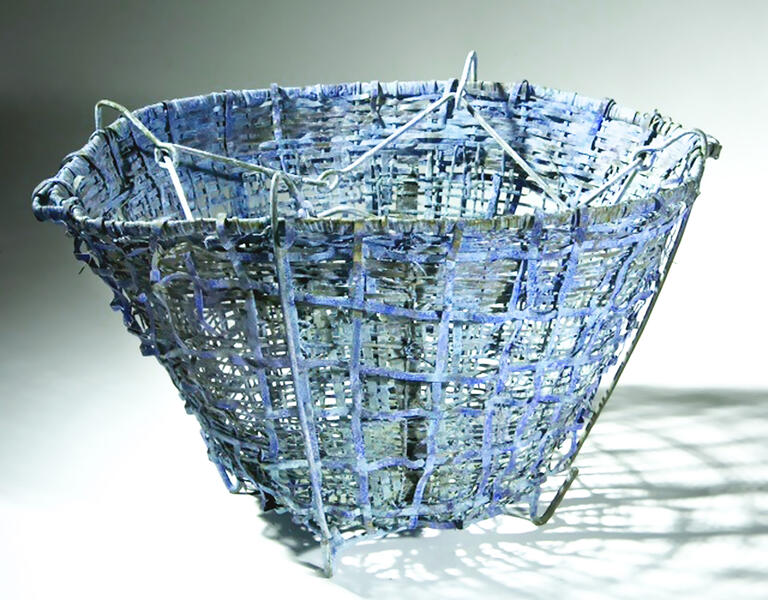 Bulb BasketTraditionally we placed bulbs in recycled, strip wood farm baskets but a grower told me a wire basket would provide more airflow and might be preferable for preserving the bulbs. So I created my own basket based on one I had seen on the Eastern Shore of Maryland. Ours is now is officially retired from bulb work and holds recycling in the winter. flowers in the summer. Bronze framework with woven copper, chemical patina fumed with ammonia 24" x 19" x18"
Bulb BasketTraditionally we placed bulbs in recycled, strip wood farm baskets but a grower told me a wire basket would provide more airflow and might be preferable for preserving the bulbs. So I created my own basket based on one I had seen on the Eastern Shore of Maryland. Ours is now is officially retired from bulb work and holds recycling in the winter. flowers in the summer. Bronze framework with woven copper, chemical patina fumed with ammonia 24" x 19" x18"
Sculpture and the Enviroment
"Live in each season as it passes; breathe the air, drink the drink, taste the fruit, and resign yourself to the influence of the earth." Henry David Thoreau
It is a gift to enjoy an object within the confines of a museum. There you can concentrate solely on the qualities of the work without distraction. If I move that same object out of doors, thoughtful placement is essential. The artwork takes on an added role; in addition to its inherent properties, the work becomes a gateway to increase the viewers' awareness of the relationship between themselves and the natural world.
When installed in the landscape, art should possess an essential kinship with the environment; like a beautiful tree, the art object reiterates the viewer's connection to the natural world.
It is a gift to enjoy an object within the confines of a museum. There you can concentrate solely on the qualities of the work without distraction. If I move that same object out of doors, thoughtful placement is essential. The artwork takes on an added role; in addition to its inherent properties, the work becomes a gateway to increase the viewers' awareness of the relationship between themselves and the natural world.
When installed in the landscape, art should possess an essential kinship with the environment; like a beautiful tree, the art object reiterates the viewer's connection to the natural world.
-
 The Orator"At first, it was only the eyes I could track, deep, watery, and of a midnight hue, darker even than the feathery blanket they peered through. The raven blinked, hopped toward the cold charcoal of last night's fire, and scooped a piece into his beak. There was no tilting of the head as to swallow; after the first unpalatable bit was cast aside, another was scooped and cast in the same fashion, four or five times before I realized what the raven wanted, my oatmeal." Josh Boling Brazed copper 60" x 30" x 23".
The Orator"At first, it was only the eyes I could track, deep, watery, and of a midnight hue, darker even than the feathery blanket they peered through. The raven blinked, hopped toward the cold charcoal of last night's fire, and scooped a piece into his beak. There was no tilting of the head as to swallow; after the first unpalatable bit was cast aside, another was scooped and cast in the same fashion, four or five times before I realized what the raven wanted, my oatmeal." Josh Boling Brazed copper 60" x 30" x 23". -
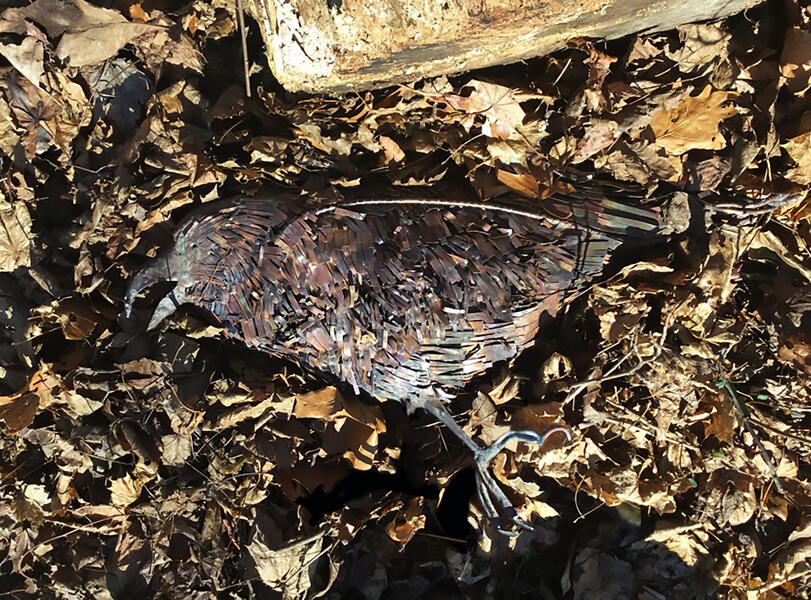 Death of the Poet LaureateUnknown Bird "Out of the dry days through the dusty leaves far across the valley those few notes never heard here before one fluted phrase floating over its wandering secret all at once wells up somewhere else and is gone before it goes on fallen into its own echo leaving a hollow through the air that is dry as before..." March 2019, Environmentalist, poet, W. S.Merwin died. His poetry awakened in me a relationship to nature, opened my eyes, inspired my work. I mourn his passing.
Death of the Poet LaureateUnknown Bird "Out of the dry days through the dusty leaves far across the valley those few notes never heard here before one fluted phrase floating over its wandering secret all at once wells up somewhere else and is gone before it goes on fallen into its own echo leaving a hollow through the air that is dry as before..." March 2019, Environmentalist, poet, W. S.Merwin died. His poetry awakened in me a relationship to nature, opened my eyes, inspired my work. I mourn his passing. -
 QuerentThe querent was designated as the one who questioned the divinator. Today, divinators are our scientists and politicians who seek knowledge by means most of us do not understand. I would like to believe that they who for-tell a challenging, bleak future because we have responded acting too slowly to reverse global warming could be wrong. A plaited copper sculpture, progressive change to patina is the result of the interaction of the copper surface with the environment. 96" x 24" x 17"
QuerentThe querent was designated as the one who questioned the divinator. Today, divinators are our scientists and politicians who seek knowledge by means most of us do not understand. I would like to believe that they who for-tell a challenging, bleak future because we have responded acting too slowly to reverse global warming could be wrong. A plaited copper sculpture, progressive change to patina is the result of the interaction of the copper surface with the environment. 96" x 24" x 17" -
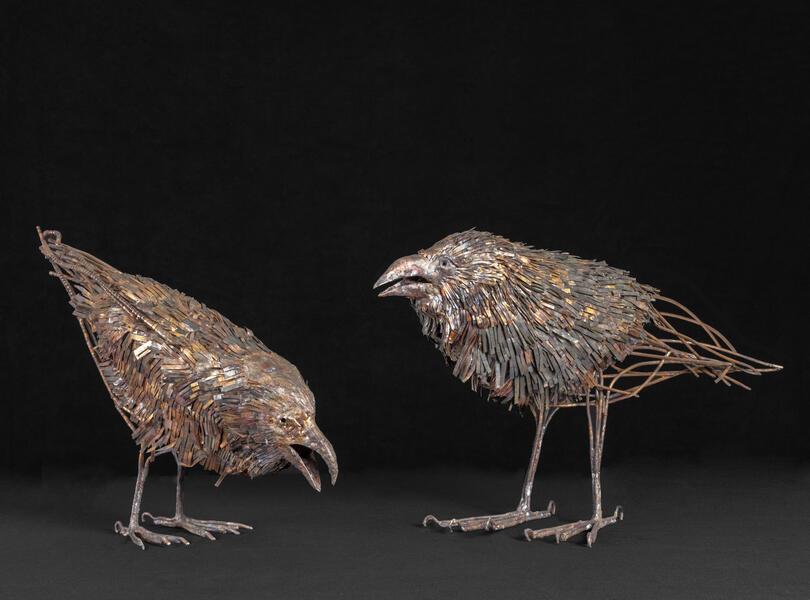 Huggin and Muggen"Hugin and Munin fly each day over the spacious earth. I fear for Hugin that he come not back, yet more anxious am I for Munin." In Norse mythology, these ravens sat on the shoulders of Odin, the raven-god. Daily, each flew the world, exploring, listening, and reported back to Odin each night. Hugin represented thinking. Munin represented memory. Plaited and brazed copper. Heat patina. Each raven is 30" x 25" x 15"
Huggin and Muggen"Hugin and Munin fly each day over the spacious earth. I fear for Hugin that he come not back, yet more anxious am I for Munin." In Norse mythology, these ravens sat on the shoulders of Odin, the raven-god. Daily, each flew the world, exploring, listening, and reported back to Odin each night. Hugin represented thinking. Munin represented memory. Plaited and brazed copper. Heat patina. Each raven is 30" x 25" x 15" -
 BalzacI always admired the power and sensitivity of Rodin's sculpture of Honore de Balzac, defiantly aloof, his cloak tightly wrapped around him, observing French society and commenting on its activities. I can easily imagine an eternally stoic, great horned owl unmoving except for the occasional twist of its head, observing, recording, and reporting on the world that surrounds him. Unlike Rodin's bronze Balzac , this observer of nature is plaited, woven, and brazed copper. 50" x 22" x 29
BalzacI always admired the power and sensitivity of Rodin's sculpture of Honore de Balzac, defiantly aloof, his cloak tightly wrapped around him, observing French society and commenting on its activities. I can easily imagine an eternally stoic, great horned owl unmoving except for the occasional twist of its head, observing, recording, and reporting on the world that surrounds him. Unlike Rodin's bronze Balzac , this observer of nature is plaited, woven, and brazed copper. 50" x 22" x 29 -
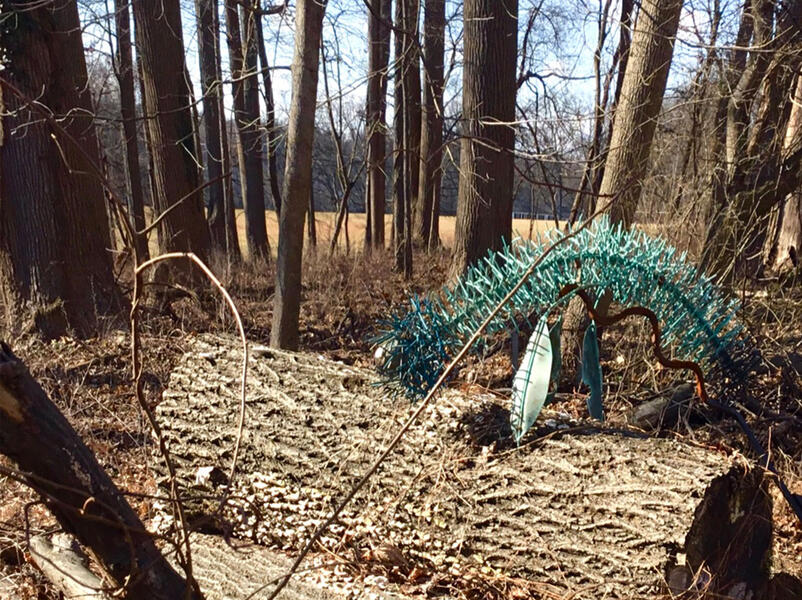 Wooly CatepillarWooly Caterpilars transform into the Isabella Tiger moth. According to folklore, the greener the patina on a bronze wooly worm in the fall, the harsher the coming winter will be. In Maryland, a traditional copper green patina will generally become whiter as it ages age except when near saltwater when the salt in the air will push the surface to a deep blue/green crust. 25" x 10" x 9"
Wooly CatepillarWooly Caterpilars transform into the Isabella Tiger moth. According to folklore, the greener the patina on a bronze wooly worm in the fall, the harsher the coming winter will be. In Maryland, a traditional copper green patina will generally become whiter as it ages age except when near saltwater when the salt in the air will push the surface to a deep blue/green crust. 25" x 10" x 9" -
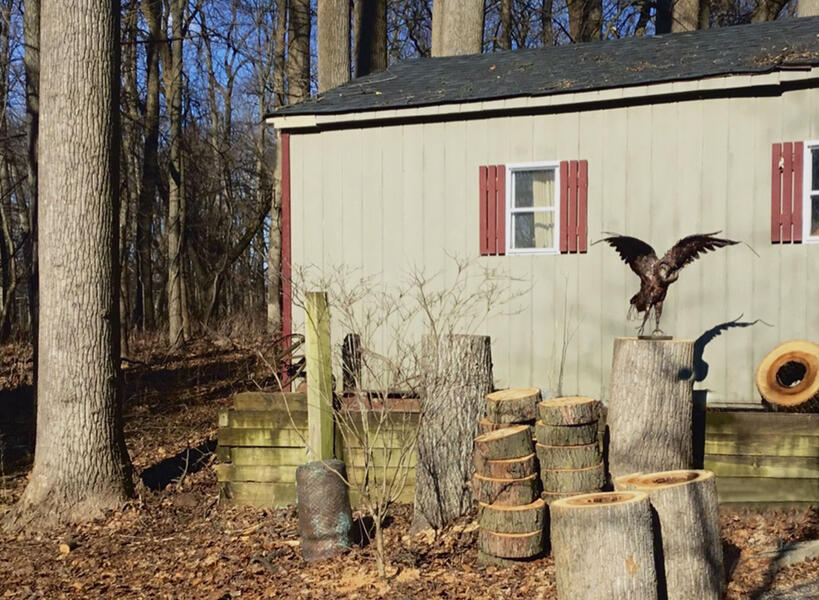 Barn OwlBarn owls nest in abandoned or little use buildings often situated near open spaces. Generally considered nocturnal, they can occasionally be seen out during the day in nesting season hunting to feed their young. Plaited and brazed copper 48" x30" x26".
Barn OwlBarn owls nest in abandoned or little use buildings often situated near open spaces. Generally considered nocturnal, they can occasionally be seen out during the day in nesting season hunting to feed their young. Plaited and brazed copper 48" x30" x26". -
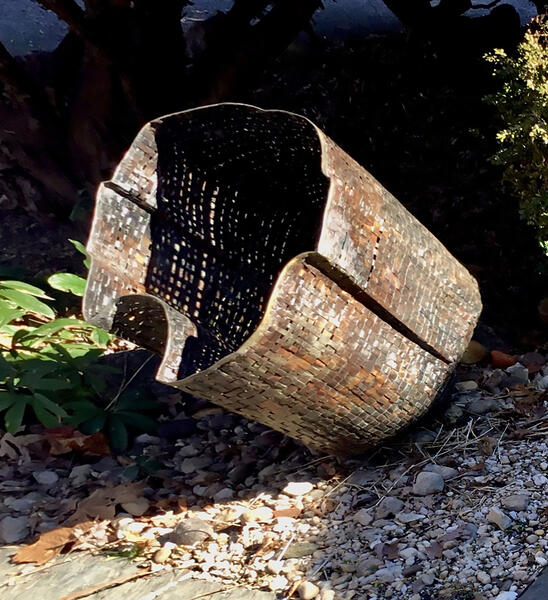 Bole No.16I never remove a tree altogether, always choosing to leave a bole, a stump of 5' to 25'. I enjoy watching the bole slowly mature, peeling off layers like an ecdysiast it reveals its inner self while providing nutrients to the soil, beauty to the landscape, and a home for insects, birds, and mammals. This plaited copper bole began life as dusty, red-orange copper. The patina constantly changing the color evolves guided by the metal's interactions with the environment. 40" x24" x30"
Bole No.16I never remove a tree altogether, always choosing to leave a bole, a stump of 5' to 25'. I enjoy watching the bole slowly mature, peeling off layers like an ecdysiast it reveals its inner self while providing nutrients to the soil, beauty to the landscape, and a home for insects, birds, and mammals. This plaited copper bole began life as dusty, red-orange copper. The patina constantly changing the color evolves guided by the metal's interactions with the environment. 40" x24" x30" -
 Bole No. 9 on log nurseryThis plaited copper bole (tree stump) began life with a red-orange coppery surface. The patina arrived at its present umber-sienna state, as part of a natural progression guided by the coppers interactions with the local environment. 38" x 18" x 15"
Bole No. 9 on log nurseryThis plaited copper bole (tree stump) began life with a red-orange coppery surface. The patina arrived at its present umber-sienna state, as part of a natural progression guided by the coppers interactions with the local environment. 38" x 18" x 15" -
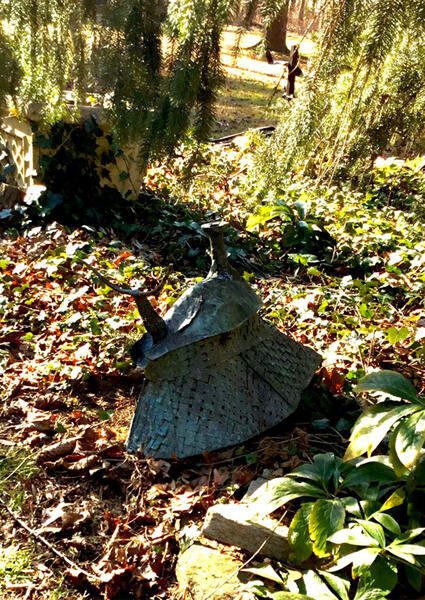 Atomic SnailSlugs and snails are a constant in my woodland garden. I attempt to control them by encouraging the local toad and bird populations (song thrushes love to eat slugs), yet the snails and slugs persist to the point where I am sure they are wearing a microscopic suit of chainmail and armor. Plaited and brazed copper with a constantly evolving patina. 24" x 17" x 18"
Atomic SnailSlugs and snails are a constant in my woodland garden. I attempt to control them by encouraging the local toad and bird populations (song thrushes love to eat slugs), yet the snails and slugs persist to the point where I am sure they are wearing a microscopic suit of chainmail and armor. Plaited and brazed copper with a constantly evolving patina. 24" x 17" x 18"
Parklands
National, state, and local parks preserve the nation's historic and cultural resources, natural landscape, native habitats, and remaining wildlife. I first experienced the Park system in my teens. I was always photographing where I was, drawing sketches and collecting bits of debris from trail sides, tidal pools, and roadways. I've maintained those visual memories cataloged in large, purple boxes, each marked with a bit of blue painter's tape. Abandoned bird, wasp, and hornet nests plucked from the ground and brush, preserving each from decay. Jagged bits of pale white, orange, and purple shells pocketed on beach walks; brown, torn, and perforated leaves of every variety, size, and shape; small bits of dead tree bark, birch white, and walnut brown; mammoth, gourd sized pinecones from the west coast and delicate, cylindrical cones from Maine; brick red and grey-speckled stones of all shapes; umber hued bits of oddly shaped oxidized metal; geometrically shaped ocean glass in shades buff-green, dusty blue and translucent white; disregarded, often fingerless work gloves; the crumpled skeletons of armless, lens-less eyewear; countless sketches on stained cardboard, scrap paper, and plywood and photographs; hundreds and hundreds of photos. Each artifact is a memory. Each memory an image; each image holds the potential for new work.
Our health and, at times, our sanity depends on being able to get outdoors. The use of parklands trails and open spaces has doubled since the Covid pandemic began, as has the thoughtlessly inappropriate disposal of trash, animal waste, and general disregard for the landscape of our parklands. Our parklands change as we use them. We have to find a way to coexist.
Our health and, at times, our sanity depends on being able to get outdoors. The use of parklands trails and open spaces has doubled since the Covid pandemic began, as has the thoughtlessly inappropriate disposal of trash, animal waste, and general disregard for the landscape of our parklands. Our parklands change as we use them. We have to find a way to coexist.
-
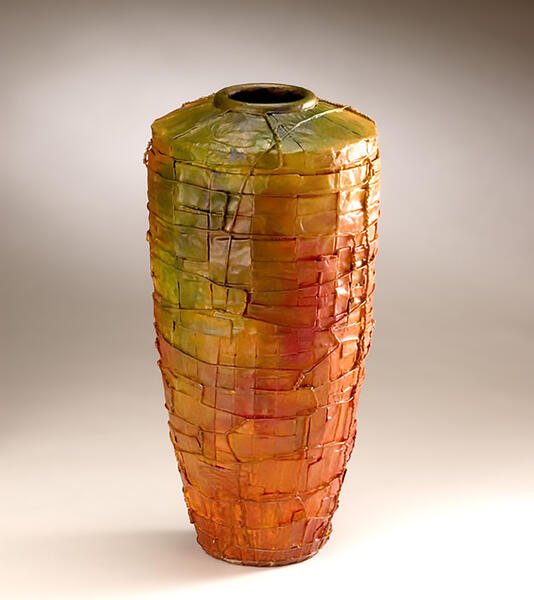 Sedimentary Limestone- Blue RidgeFrom various entry points in Virginia to Asheville, NC, by way of Fancy Gap, I’ve made the drive 100 times on my way to and from southern destinations. It’s slow traveling, but the views and overlooks are worth the time. I travel the Blue Ridge in the fall. That’s when my exhibitions are scheduled in this part of the country; the waning deciduous leaf color combined with adelgid devastated hemlocks gives the ride an at times somber feel. But, I enjoy the quiet, the slow pace, the misty fall colors, and the absence of trucks. Plaited copper over a turned wood substructure, knotted steel wire, chemical patina, polychrome 17" x 7" x7"
Sedimentary Limestone- Blue RidgeFrom various entry points in Virginia to Asheville, NC, by way of Fancy Gap, I’ve made the drive 100 times on my way to and from southern destinations. It’s slow traveling, but the views and overlooks are worth the time. I travel the Blue Ridge in the fall. That’s when my exhibitions are scheduled in this part of the country; the waning deciduous leaf color combined with adelgid devastated hemlocks gives the ride an at times somber feel. But, I enjoy the quiet, the slow pace, the misty fall colors, and the absence of trucks. Plaited copper over a turned wood substructure, knotted steel wire, chemical patina, polychrome 17" x 7" x7" -
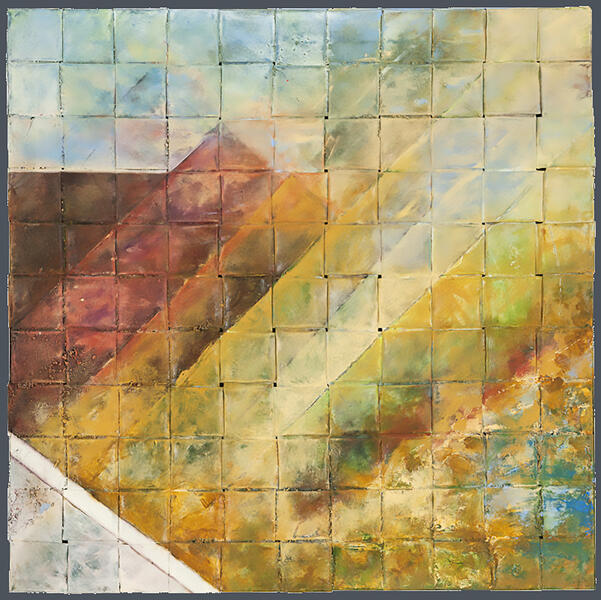 Great Smoky MountainsLate summer in the Smokys north of Gatlinburg, Tennessee. Recycled materials gathered in gatlinburg, woven copper, chemical patina, polychrome 24" x24" x2"
Great Smoky MountainsLate summer in the Smokys north of Gatlinburg, Tennessee. Recycled materials gathered in gatlinburg, woven copper, chemical patina, polychrome 24" x24" x2" -
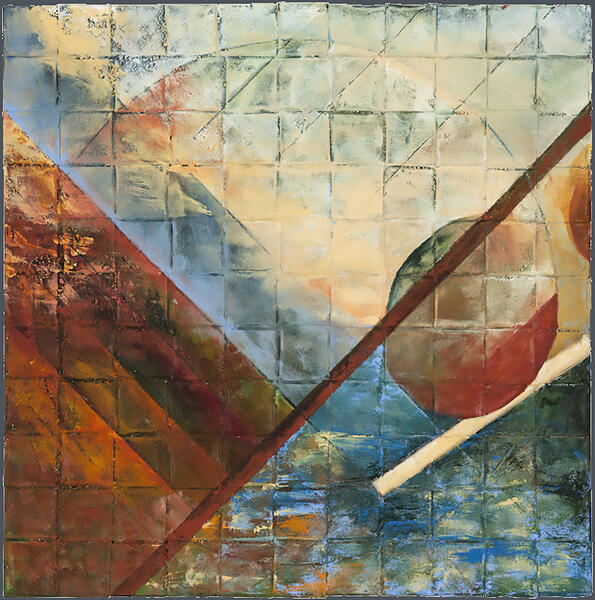 Acadia National Park-SeawallWaves continually crash on this easterly point of land. Rocks are tossed from the tiny sand beach strip inland; as tides roll in, heavier stones are piled on and around smaller ones. Tidal pools form, filled with life; they perish and persist in the continually changing landscape. Plaited copper, multiple chemical patinas, recycled materials polychrome 24" x 24" x 2".
Acadia National Park-SeawallWaves continually crash on this easterly point of land. Rocks are tossed from the tiny sand beach strip inland; as tides roll in, heavier stones are piled on and around smaller ones. Tidal pools form, filled with life; they perish and persist in the continually changing landscape. Plaited copper, multiple chemical patinas, recycled materials polychrome 24" x 24" x 2". -
 Appalachain PlateauPassing through the Cumberland Mountains on my way to Chicago, September 2017. I have a 13-hour drive in front of me, but from my vantage point on 68 west, as I exit Sideling Hill road cut, I have to pull over, the spectacular fall foliage spills over the valleys in front of me. Just glorious. 20 minutes later, I am on my way, a few photos taken; I ponder sleeping in my van in the Elkhart truck stop that night. Copper over a turned wood substructure, knotted steel wire, chemical patina, polychrome 9' x 9.5" x 9."
Appalachain PlateauPassing through the Cumberland Mountains on my way to Chicago, September 2017. I have a 13-hour drive in front of me, but from my vantage point on 68 west, as I exit Sideling Hill road cut, I have to pull over, the spectacular fall foliage spills over the valleys in front of me. Just glorious. 20 minutes later, I am on my way, a few photos taken; I ponder sleeping in my van in the Elkhart truck stop that night. Copper over a turned wood substructure, knotted steel wire, chemical patina, polychrome 9' x 9.5" x 9." -
 Eclipse from BeaverbrookNovember 2020. Pandemic, social unrest, economic strain, and the brief glimpse of a penumbral lunar eclipse. Hope springs eternal. Plaited copper, multiple chemical patinas, recycled materials polychrome 24" x 24" x 2".
Eclipse from BeaverbrookNovember 2020. Pandemic, social unrest, economic strain, and the brief glimpse of a penumbral lunar eclipse. Hope springs eternal. Plaited copper, multiple chemical patinas, recycled materials polychrome 24" x 24" x 2". -
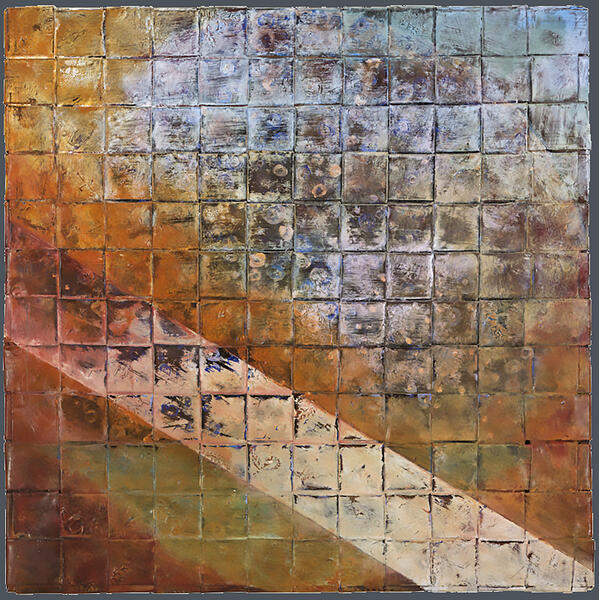 ShenandoahDriving south on 81, to my left lies the park. The Skyline Drive runs its length. The decision of a moment, I take the road less traveled and arrive in Atlanta a day late but happier. Woven Copper. Chemical patina and polychrome. 24" x 24" x 2"
ShenandoahDriving south on 81, to my left lies the park. The Skyline Drive runs its length. The decision of a moment, I take the road less traveled and arrive in Atlanta a day late but happier. Woven Copper. Chemical patina and polychrome. 24" x 24" x 2" -
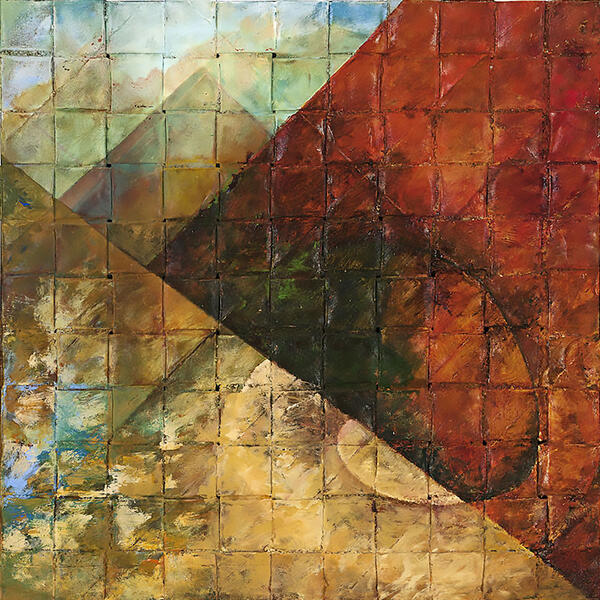 BandelierI parked and immediately noticed 2 signs."Extremely Narrow Canyon" and "Those with heart conditions do not proceed". I had been told only the most physically fit should consider scaling the steep-walled canyon paths of Bandolier; disheartened I began to turn back. Then I noticed 2, 300lb. tourists in flip-flops exiting the canyon. What the hell! Ignoring the warnings I scramble with little difficulty to the top. My Dad always said don't take no for an answer. 24" x 24" x 2"
BandelierI parked and immediately noticed 2 signs."Extremely Narrow Canyon" and "Those with heart conditions do not proceed". I had been told only the most physically fit should consider scaling the steep-walled canyon paths of Bandolier; disheartened I began to turn back. Then I noticed 2, 300lb. tourists in flip-flops exiting the canyon. What the hell! Ignoring the warnings I scramble with little difficulty to the top. My Dad always said don't take no for an answer. 24" x 24" x 2" -
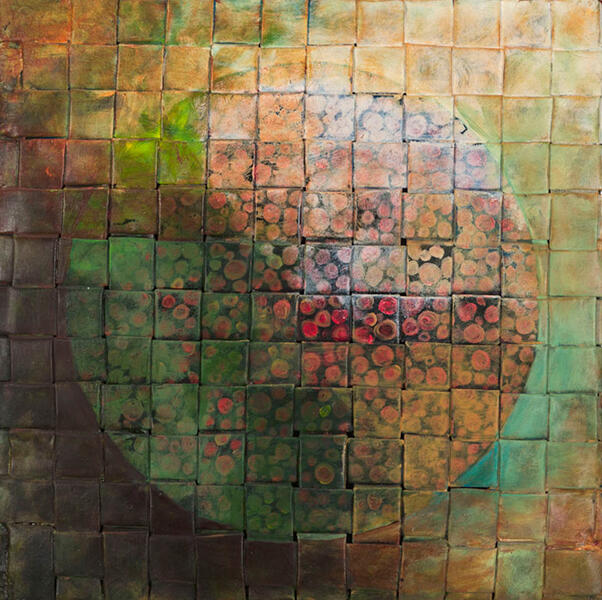 Sunspots on BeaverbrookPicnicking at my friend's home in rural West Virginia, we somehow got around to discussing astronomy when Jean Pierre said he knew a method to view sunspots. I said I had never seen a sunspot except in a book. So he got out his telescope, focused on the sun, and then projected the image onto my salad stained, no longer, white lunch plate. Viola! Sunspots Copper, chemical patina, polychrome 24" x 24" x 2"
Sunspots on BeaverbrookPicnicking at my friend's home in rural West Virginia, we somehow got around to discussing astronomy when Jean Pierre said he knew a method to view sunspots. I said I had never seen a sunspot except in a book. So he got out his telescope, focused on the sun, and then projected the image onto my salad stained, no longer, white lunch plate. Viola! Sunspots Copper, chemical patina, polychrome 24" x 24" x 2" -
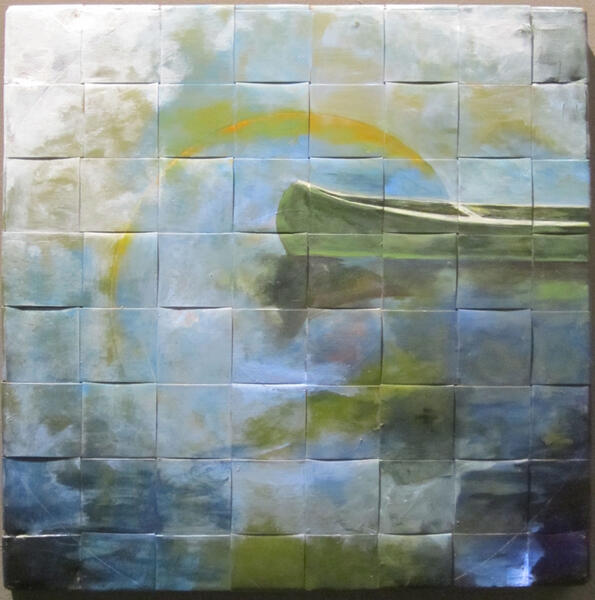 Echo Lake Beach-Acadia National ParkThere must be 100’s of Echo lakes in the world but, to anyone who has ever visited Maine, Echo lake means only one thing, Echo Lake Beach in Acadia National Park. A crystal clear freshwater lake at the foot of Beech mountain. In the early morning, before the crowds arrive, it’s a serenely quiet and contemplative space often glazed in grey morning mists 24" x24" x2"
Echo Lake Beach-Acadia National ParkThere must be 100’s of Echo lakes in the world but, to anyone who has ever visited Maine, Echo lake means only one thing, Echo Lake Beach in Acadia National Park. A crystal clear freshwater lake at the foot of Beech mountain. In the early morning, before the crowds arrive, it’s a serenely quiet and contemplative space often glazed in grey morning mists 24" x24" x2" -
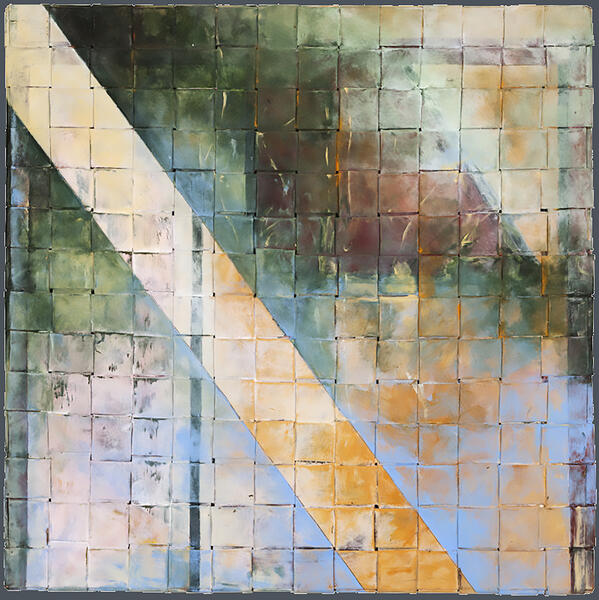 Water coursing through Rocky Gap gorgeRocky Gap gorge in western Maryland with the rhododendron and mountain laurel in bloom. Copper, chemical patina, polychrome. 24" x24" x2".
Water coursing through Rocky Gap gorgeRocky Gap gorge in western Maryland with the rhododendron and mountain laurel in bloom. Copper, chemical patina, polychrome. 24" x24" x2".
Signature Land Use Patterns
"Land use patterns" describes the earth's designed utilization as determined by the topographic features, geologic features, population density, economics, climate, availability of water, mature growth forests, and required need.
There are 7 generally recognized land-use patterns; residential, institutional, industrial, road-green belt, roadside, park, and forest. To those, I would add 7 more; sustainable-waterways, industrial-waterways, industrial-devastation, industrial-farming, sustainable-farming, reclaimed-residential, and scenic-roadways.
The study of land use patterns allows the appropriate application of resources, assists cities in planning future growth, and farmers to plan crop rotation. Environmentalists employ them to study the health of woodlands and water, research the utilization of new technology and apply sustainable practices.
Land patterns also describe our reaction to the designs we notice when in a plane, flying over the patchwork quilt of the earth below, which many employ to inspire us.
There are 7 generally recognized land-use patterns; residential, institutional, industrial, road-green belt, roadside, park, and forest. To those, I would add 7 more; sustainable-waterways, industrial-waterways, industrial-devastation, industrial-farming, sustainable-farming, reclaimed-residential, and scenic-roadways.
The study of land use patterns allows the appropriate application of resources, assists cities in planning future growth, and farmers to plan crop rotation. Environmentalists employ them to study the health of woodlands and water, research the utilization of new technology and apply sustainable practices.
Land patterns also describe our reaction to the designs we notice when in a plane, flying over the patchwork quilt of the earth below, which many employ to inspire us.
-
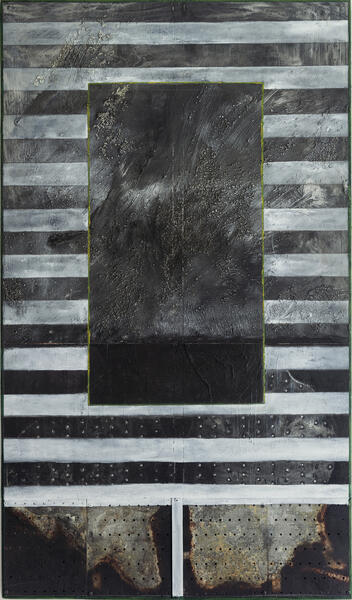 Industrial-Storm CloudsWood, repurposed perforated steel plates, steel bars, sand, dirt, industrial grit, polychrome. 41" x 24" x2"
Industrial-Storm CloudsWood, repurposed perforated steel plates, steel bars, sand, dirt, industrial grit, polychrome. 41" x 24" x2" -
 Parkland-AzeleaWoven copper, chemical patina, polychrome. 48" x 12" x 1.25"
Parkland-AzeleaWoven copper, chemical patina, polychrome. 48" x 12" x 1.25" -
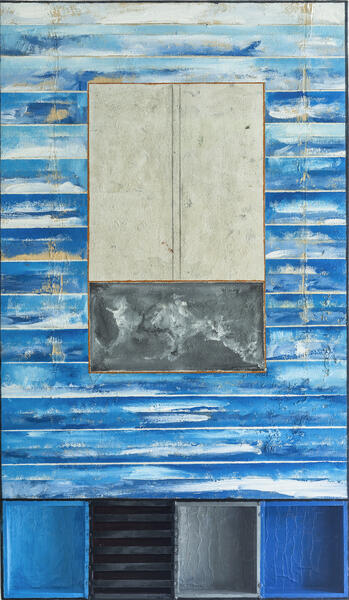 Industrial-Water-wayWood, steel bar, repurposed steel plates, sand, industrial grid, recycled newspaper, polychrome 41" x 24" x 2"
Industrial-Water-wayWood, steel bar, repurposed steel plates, sand, industrial grid, recycled newspaper, polychrome 41" x 24" x 2" -
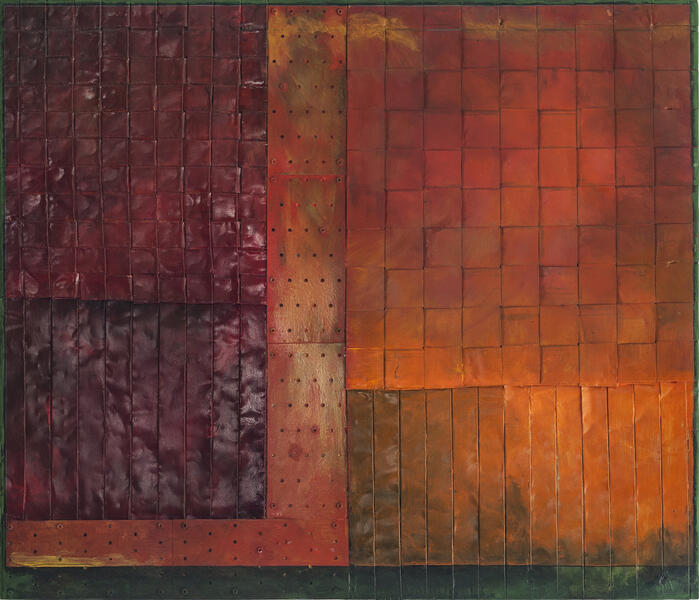 Roadside-BeaverbrookPlaited copper, repurposed perforated steel plate, chemical patina, polychrome. 24" x 28" x1"
Roadside-BeaverbrookPlaited copper, repurposed perforated steel plate, chemical patina, polychrome. 24" x 28" x1" -
 Roadside- Beaverbrook No.2Plaited copper, repurposed perforated steel plate, industrial grit, chemical patina, polychrome. 24" x 28" x 1.25"
Roadside- Beaverbrook No.2Plaited copper, repurposed perforated steel plate, industrial grit, chemical patina, polychrome. 24" x 28" x 1.25" -
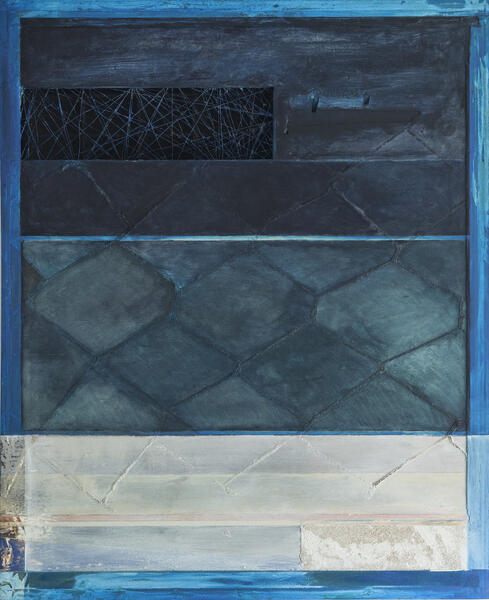 Institutional-Pool No.1Wood, repurposed hollow-core door, repurposed steel, recycled steel wire, recycled newspaper, polychrome. 30.5" x 37.5" x 1.5"
Institutional-Pool No.1Wood, repurposed hollow-core door, repurposed steel, recycled steel wire, recycled newspaper, polychrome. 30.5" x 37.5" x 1.5" -
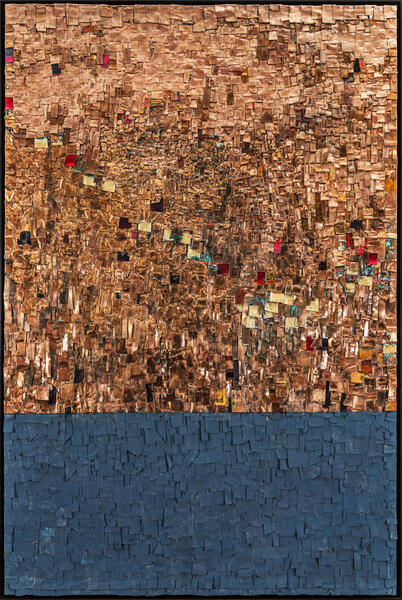 Desperate ForestCopper scrap from a roofing installation and gutter replacement. Chemical patina and polychrome 30.5" x 46" x 2"
Desperate ForestCopper scrap from a roofing installation and gutter replacement. Chemical patina and polychrome 30.5" x 46" x 2" -
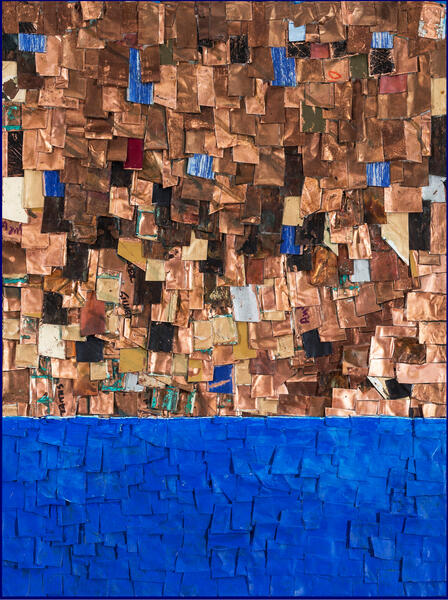 New Growth-ForestCopper scrap from a roofing installation and gutter replacement. Chemical patina and polychrome. 24" x 37" x 2"
New Growth-ForestCopper scrap from a roofing installation and gutter replacement. Chemical patina and polychrome. 24" x 37" x 2" -
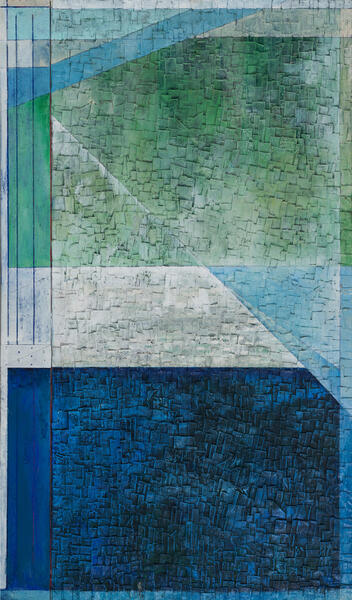 Road GreenbeltCopper scrap from a slitting company, wood, steel bar, salvaged perforated steel plates chemical patina and polychrome. 28" x 48" x 2"
Road GreenbeltCopper scrap from a slitting company, wood, steel bar, salvaged perforated steel plates chemical patina and polychrome. 28" x 48" x 2" -
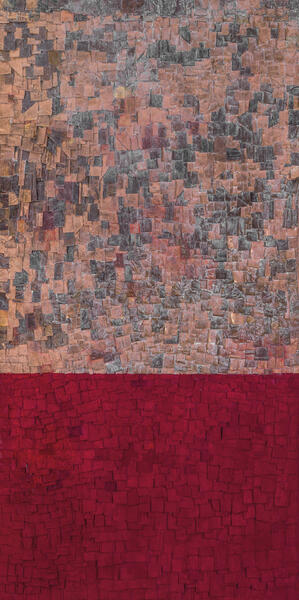 Industrial-RoadsideCopper scrap from a roofing installation and gutter replacement. Chemical patina and polychrome. 30" x 61" x 2"
Industrial-RoadsideCopper scrap from a roofing installation and gutter replacement. Chemical patina and polychrome. 30" x 61" x 2"


